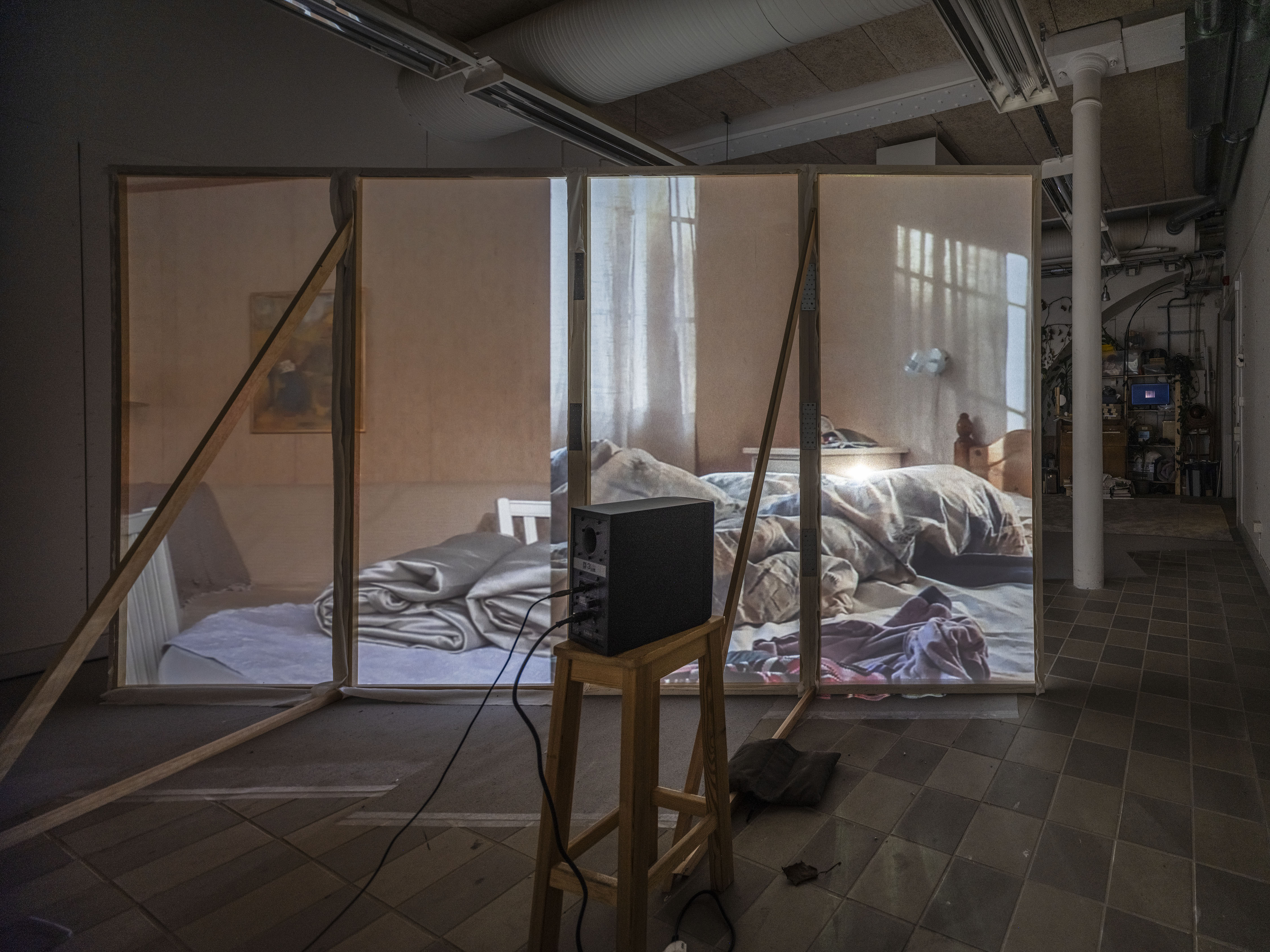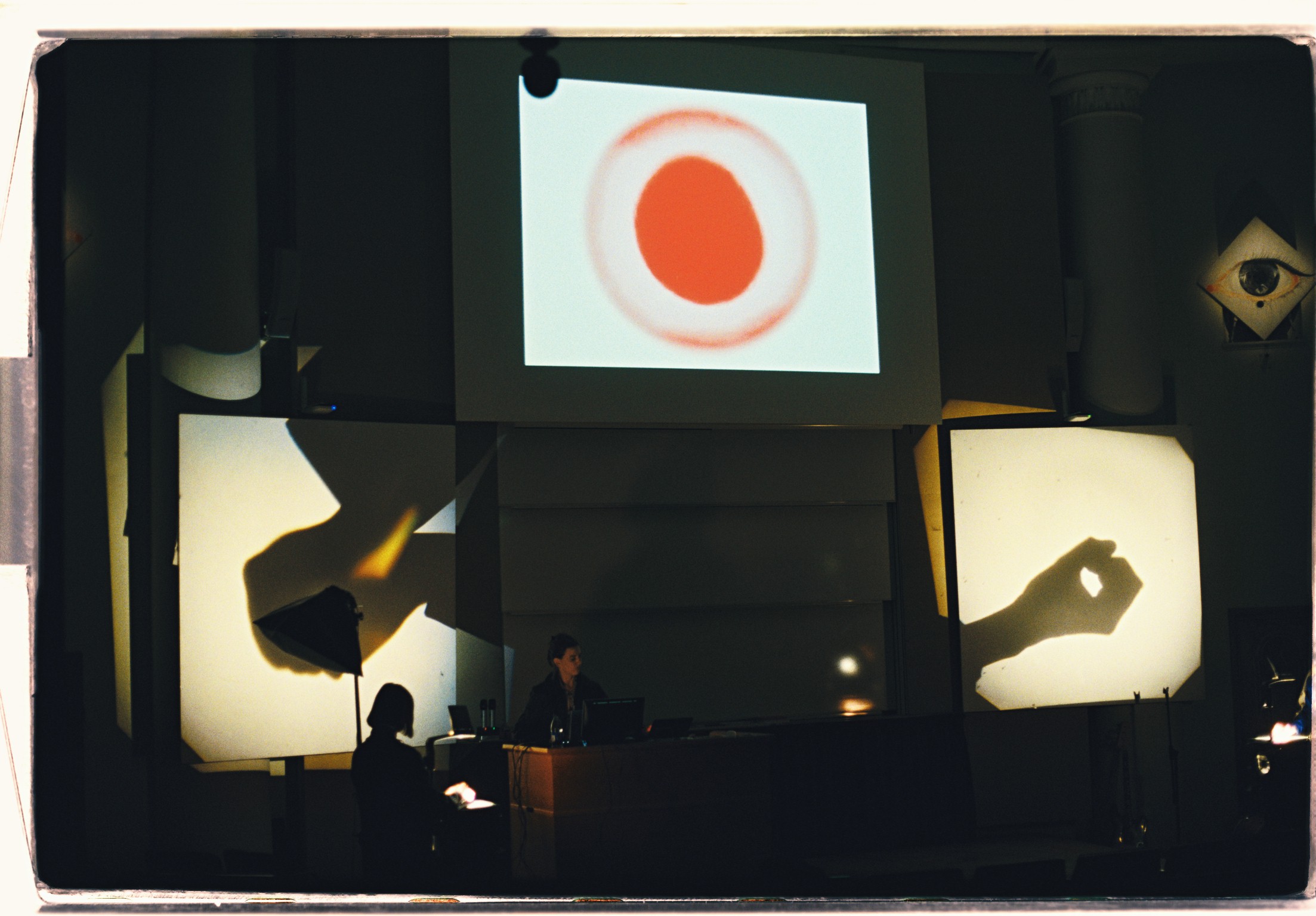
Sofia Romberg
B.87 Åland Islands, Finland
Lives in Stockholm
Visual artist & scenographer.
My practice is engaged with connecting intimate life with social structures & existential conditions. Asking questions about our vulnerability, changeability & agency. Bridging past events with the present tense, fabrication with materiality.
My practice as a scenographer also connects to my interest in storytelling, collective processes & communal live encounters.
Education
2023 - 2025
MFA Royal Institute of Art, Stockholm
2021 -2023
BFA Royal Institute of Art, Stockholm
2020-2021
Art in the Open – Social Dimensions, Ecologies & Transformations / Konstfack, Stockholm
2017
Ways of seeing / Konstfack, Stockholm
2013
Artistic Theories, Methods and Practices / SADA
2010-2013
BFA, Set-Design / SADA
2008-2010
Preparatory Art School / Idun Lovén, Stockholm
Stage / Art
2025
Sanningsland by Elsa Berggren.
Scenography, Costume & Mask Design,
Teater Giljotin / Stockholm
Hjorten Skulpturpark
Curated by Maria Toll & Nikki Fager Myrholm / Stockholm
The MA Spring Show
Exhibition team: Johanna Gustafsson Fürst, Silvia Thomackenstein & Jenny Olsson
The Art Academy / Stockholm
Fringe Gallery
Solo Show / Vaasa
Nästa hållplats: Du Jag Nu by Laura Wihlborg.
Costume & Mask Design,
Ung Scen Öst / Linköping
2024
Kattpromenaden by Sara Lundberg & Emily Magorrian.
Set & Costume Design,
Dramaten / Stockholm
Landskap med solar,
Solo exhibition,
Galleri Mejan / Stockholm
Incus by Anna Öberg,
Set Design / Tour
Pojkvännen by Ninna Tersman.
Set & Costume Design,
Ung Scen Öst / Linköping
Frank, Franka och jag by Emelie Östergren.
Set & Costume Design,
Dramaten / Stockholm
2023
The Bachelor Show, Curated by Bella Rune & Jonas Nobel,
The Royal Art Academy / Stockholm
A place near by, by Tove Skeidsvoll,
spatial eye and collaborator,
Weld & SITE / Stockholm
Stuff it, Group Show,
Bonniers Konsthall / Stockholm
2022
Att sjunka genom jorden,
Omställning Skärholmen, paper works by 4 local artists. Concept Laus Østergaard
Lidan Lyser, Sketch proposition for a light-exhibition walk, invited by Lidköpings Kommun & Lidköpings Konsthall
Mikro Makro (the filmversion no.2),
by Nomodaco,
Animation / Graphic / Costume
2021
Mikro Makro (the filmversion), by Nomodaco, Animation / Graphic
Bludderblad, by Ingrid Olterman Danskompani,
Set Design & Costume
SAMVARON, by Anna Öberg. Set Design / Tour
Terrarium “First Year Show”,
The Royal Art Academy / Stockholm
2020
Textilparken, organic group exhibition at Björkö, Åland, curated by SIMKA
Time Strollers, Connecting Georgia: Virtual & Live Group Exhibition between Stockholm, Batumi and Gdansk hosted by Intercult, curated by SIMKA
Hör så tyst det låter, by Nyxxx,
Set Design & Costume / Regionteatern Blekinge & Kronoberg
Mikro Makro, by Nomodaco in collaboration with Norrlandsoperan,
Set Design & Costume / Tour
2019Mikro Makro Workshops,
SITE / Stockholm
Living Documents, concept by Charlotta Ruth & Dominique Grunbuhel,
Set Design & Props, MDT / Stockholm
Vem är rädd för Rödluvan by Emelie Östergren, Set Design & Costume / Örebro Länsteater
2018
Det finns ingenting att vara rädd för by Sara Giese (Book by Johan Heltne),
Set Design & Costume / Uppsala Stadsteater
Uppgång och Fall, by Sara Giese (Book by Liv Strömqvist),
Set Design & Costume / Uppsala Stadsteater
Treasure Hunting, interactive performance piece by Charlotta Grunbuhel Ruth,
Set Design & Props, WUC / Vienna
Slutet enligt Rut by Jesper Weithz,
Set Design & Costume / Riksteatern
Grants
Konstakademien
Svenska Kulturfonden
Konstsällskapet Våga Se
Ålands Kulturdelegation
Konstnärsnämnden
Ålands Kulturstiftelse
Through the Looking Screen
5,3 x 3 m (16:9) Curtain Installation
2022 -


Made from discarded theater silk-curtains, re-colored black while letting its past stitchings and patterns still shine through. The hole in the middle is cut out and possible to step through. The title and work draws inspiration from the book Through the Looking-Glass, and What Alice Found There by Lewis Carrol (1871).
I am drawn to re-use and mis-use the tools from the theatre - off stage. The curtain has historically been used within the playhouses as a division between audience (reality) and the stage (fiction). Curtains are
often also used for more practical reasons: making the sound environment less brute, controlling the light and making hiding spaces for props and actors. The curtains I worked with here are about three decades old and have an immaterial archive of their own that I
wanted to display by placing it in a setting where you can view it from both sides in a day-light setting.
The curtain was also part of the play “The Opening Night” directed by the artist Iris Smeds 2023
at The Art Academy. We were asked to use a work of our own and create a script/life around it, all our parts were then assembled
and became material for the play that Iris wrote. I used the curtain as a point of departure and wrote it a monologue that I shared from the stage wrapped around it.
Made from discarded theater silk-curtains, re-colored black while letting its past stitchings and patterns still shine through. The hole in the middle is cut out and possible to step through. The title and work draws inspiration from the book Through the Looking-Glass, and What Alice Found There by Lewis Carrol (1871).
I am drawn to re-use and mis-use the tools from the theatre - off stage. The curtain has historically been used within the playhouses as a division between audience (reality) and the stage (fiction). Curtains are
often also used for more practical reasons: making the sound environment less brute, controlling the light and making hiding spaces for props and actors. The curtains I worked with here are about three decades old and have an immaterial archive of their own that I
wanted to display by placing it in a setting where you can view it from both sides in a day-light setting.
The curtain was also part of the play “The Opening Night” directed by the artist Iris Smeds 2023
at The Art Academy. We were asked to use a work of our own and create a script/life around it, all our parts were then assembled
and became material for the play that Iris wrote. I used the curtain as a point of departure and wrote it a monologue that I shared from the stage wrapped around it.
and became material for the play that Iris wrote. I used the curtain as a point of departure and wrote it a monologue that I shared from the stage wrapped around it.
![]()
![]()
CREDITS LilaRo Skrädderikompani & Riksteatern


Hus, trädgård och så vidare bortåt
Film 16:9 & Installation // HD 66:00 min
2023
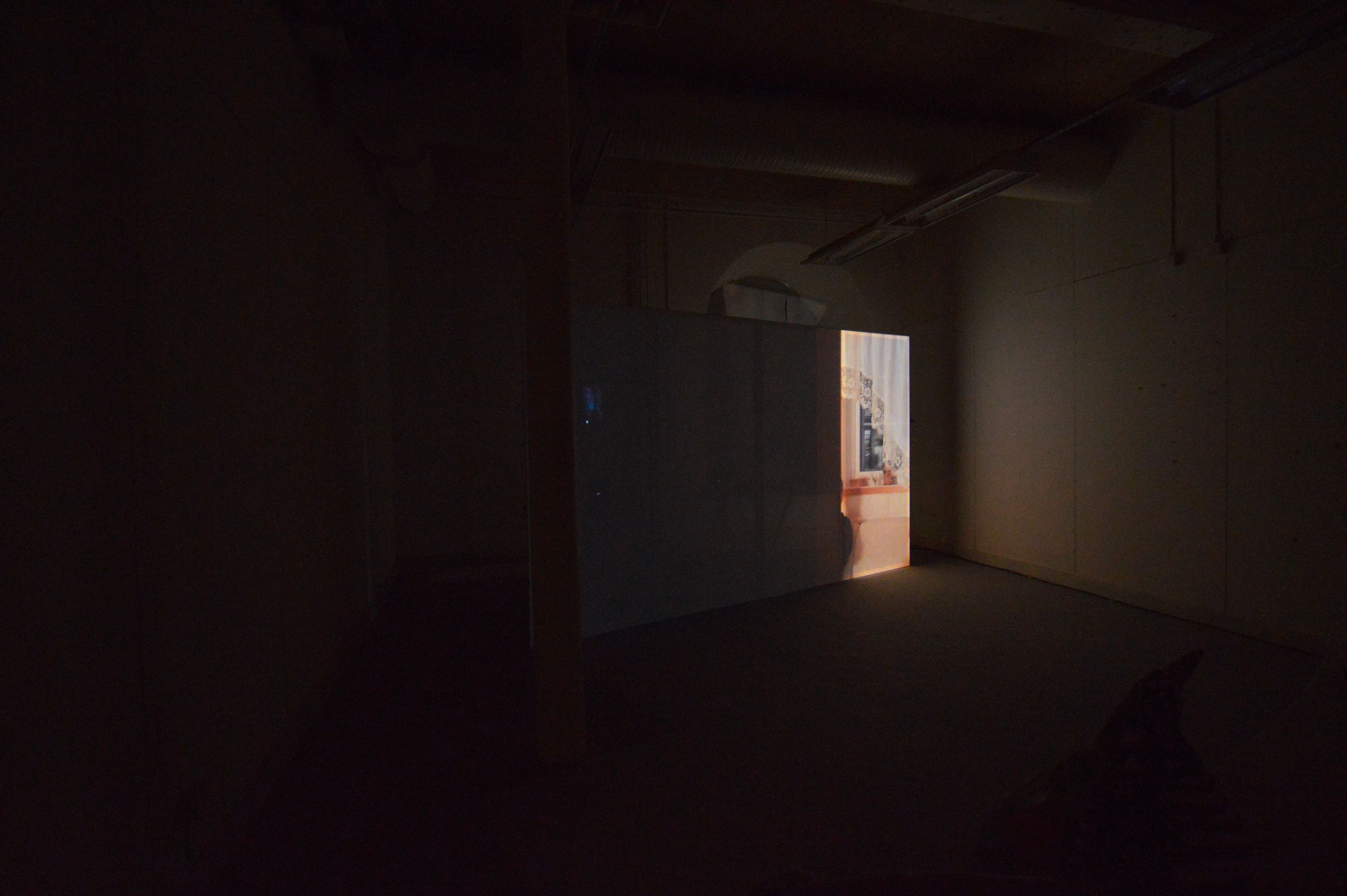
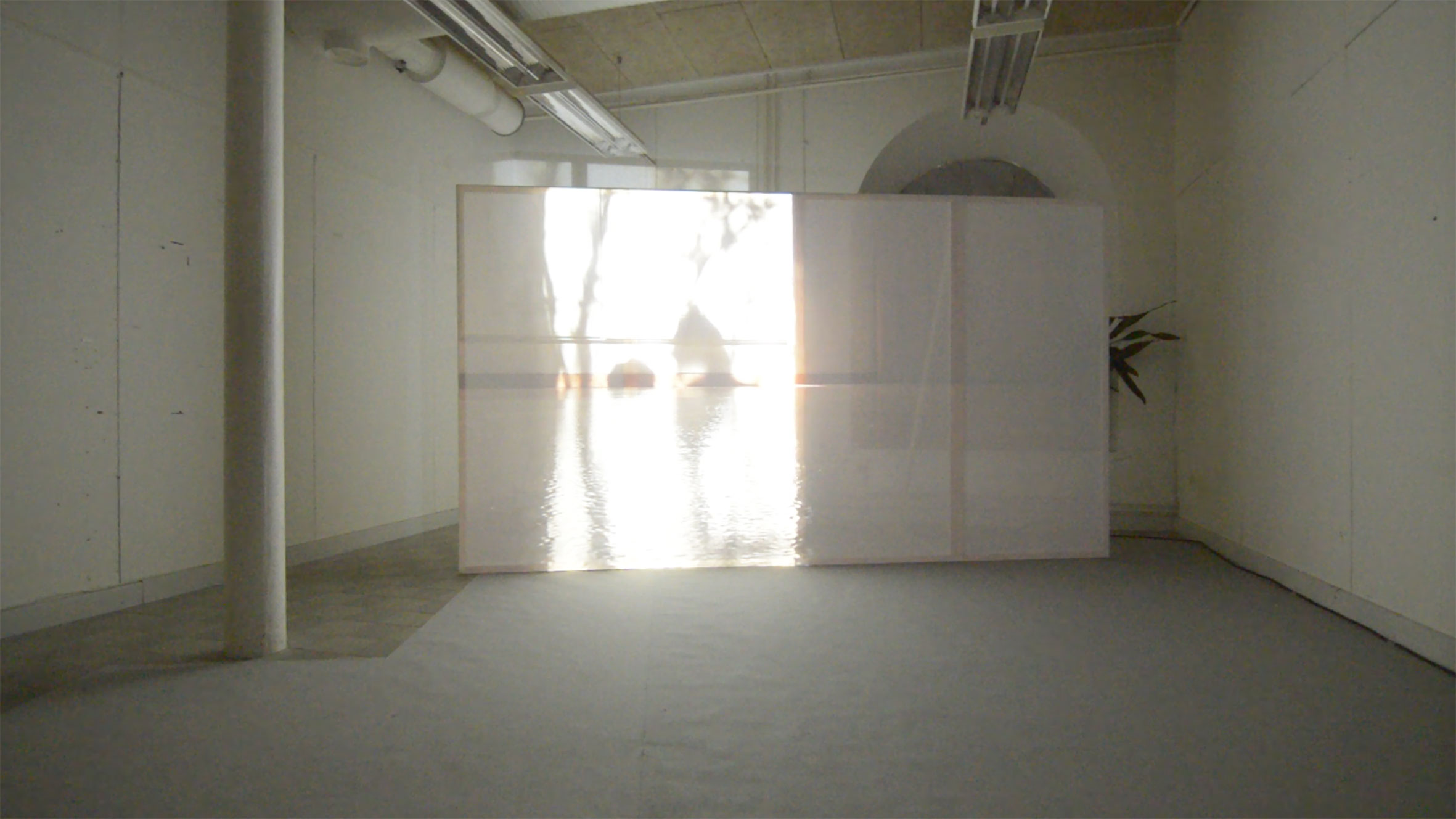
![]()
![]()
”The everyday imposes its monotony. It is the invariable constant of the variations it envelops. The days follow one after another and resemble one another, and yet - here lies the contradiction at the heart of everydayness - everything changes.”
From Henri Lefvebres essay ”The Everyday and Everydayness” 1987
House, Garden and So Forth Beyond was filmed between the summer of 2021 and 2022 in the house and garden that belonged to my grandparents Sture and Reetta. A single camera placed on furnitures, flower boards and the ground documents the ebb and flow of everyday encounters between generations, internal and external events, still and active life, intimacy and loss, without a hierarchy in-between.
This visual setting of “the flow of time” during a one year time frame is accompanied by sounds from the films mainly disconnected from the images; The radios disparate tableau, fragments from conversations and environmental sounds. The captions is a montage from transcriptions of our voices, milieu and descriptions from a manual regarding Super-8 screening.
![]()
![]()
![]()
![]()
![]()
![]()
![]()
![]()
![]()
![]()
![]()
![]()
![]()
![]()
![]()
![]()
![]()
The installation was built in a newly emptied storage room for tech equipment at the Royal Institute of Art. I was interested to work in a space with its own personal traces, like if caught in an in-between - about to move in or out? I covered parts of the floor with a paper often used during renovations, and placed a soft carpet on another part for its domestic and welcoming quality along with garden chairs. In the back of the space I built an installation with props from my grandparents home, as well with objects from the original space. Here I placed a screen with the sibling piece Ljusår that consits of my grandfathers Super-8 recordings viewed from the monitor of a Vu-Editor, while its beeing scrolled through. The main film was projected on four connected screens covered in thin cotton, letting the construction shine through and the image to bleed out and reflect the surfaces behind and above it.
Camera & Editing Sofia Romberg
Super - 8 Sture Romberg
Text Animation Rahul Gunnarsson
Sound Design Jon Lennblad & Sofia Romberg
Special thanks to my professor Ming Wong & the input from the student group of performance in the expanded field at the Royal Institut of Art during this process, aswell the awing technical support from Caio Marques De Oliveira and Astrid Braide Eriksson <3
”The everyday imposes its monotony. It is the invariable constant of the variations it envelops. The days follow one after another and resemble one another, and yet - here lies the contradiction at the heart of everydayness - everything changes.”
From Henri Lefvebres essay ”The Everyday and Everydayness” 1987
From Henri Lefvebres essay ”The Everyday and Everydayness” 1987
House, Garden and So Forth Beyond was filmed between the summer of 2021 and 2022 in the house and garden that belonged to my grandparents Sture and Reetta. A single camera placed on furnitures, flower boards and the ground documents the ebb and flow of everyday encounters between generations, internal and external events, still and active life, intimacy and loss, without a hierarchy in-between.
This visual setting of “the flow of time” during a one year time frame is accompanied by sounds from the films mainly disconnected from the images; The radios disparate tableau, fragments from conversations and environmental sounds. The captions is a montage from transcriptions of our voices, milieu and descriptions from a manual regarding Super-8 screening.
![]()
![]()
![]()
![]()
![]()
![]()
![]()
![]()
![]()
![]()
![]()
![]()
![]()
![]()
![]()
![]()
![]()
The installation was built in a newly emptied storage room for tech equipment at the Royal Institute of Art. I was interested to work in a space with its own personal traces, like if caught in an in-between - about to move in or out? I covered parts of the floor with a paper often used during renovations, and placed a soft carpet on another part for its domestic and welcoming quality along with garden chairs. In the back of the space I built an installation with props from my grandparents home, as well with objects from the original space. Here I placed a screen with the sibling piece Ljusår that consits of my grandfathers Super-8 recordings viewed from the monitor of a Vu-Editor, while its beeing scrolled through. The main film was projected on four connected screens covered in thin cotton, letting the construction shine through and the image to bleed out and reflect the surfaces behind and above it.
Camera & Editing Sofia Romberg
Super - 8 Sture Romberg
Text Animation Rahul Gunnarsson
Sound Design Jon Lennblad & Sofia Romberg
Special thanks to my professor Ming Wong & the input from the student group of performance in the expanded field at the Royal Institut of Art during this process, aswell the awing technical support from Caio Marques De Oliveira and Astrid Braide Eriksson <3
This visual setting of “the flow of time” during a one year time frame is accompanied by sounds from the films mainly disconnected from the images; The radios disparate tableau, fragments from conversations and environmental sounds. The captions is a montage from transcriptions of our voices, milieu and descriptions from a manual regarding Super-8 screening.
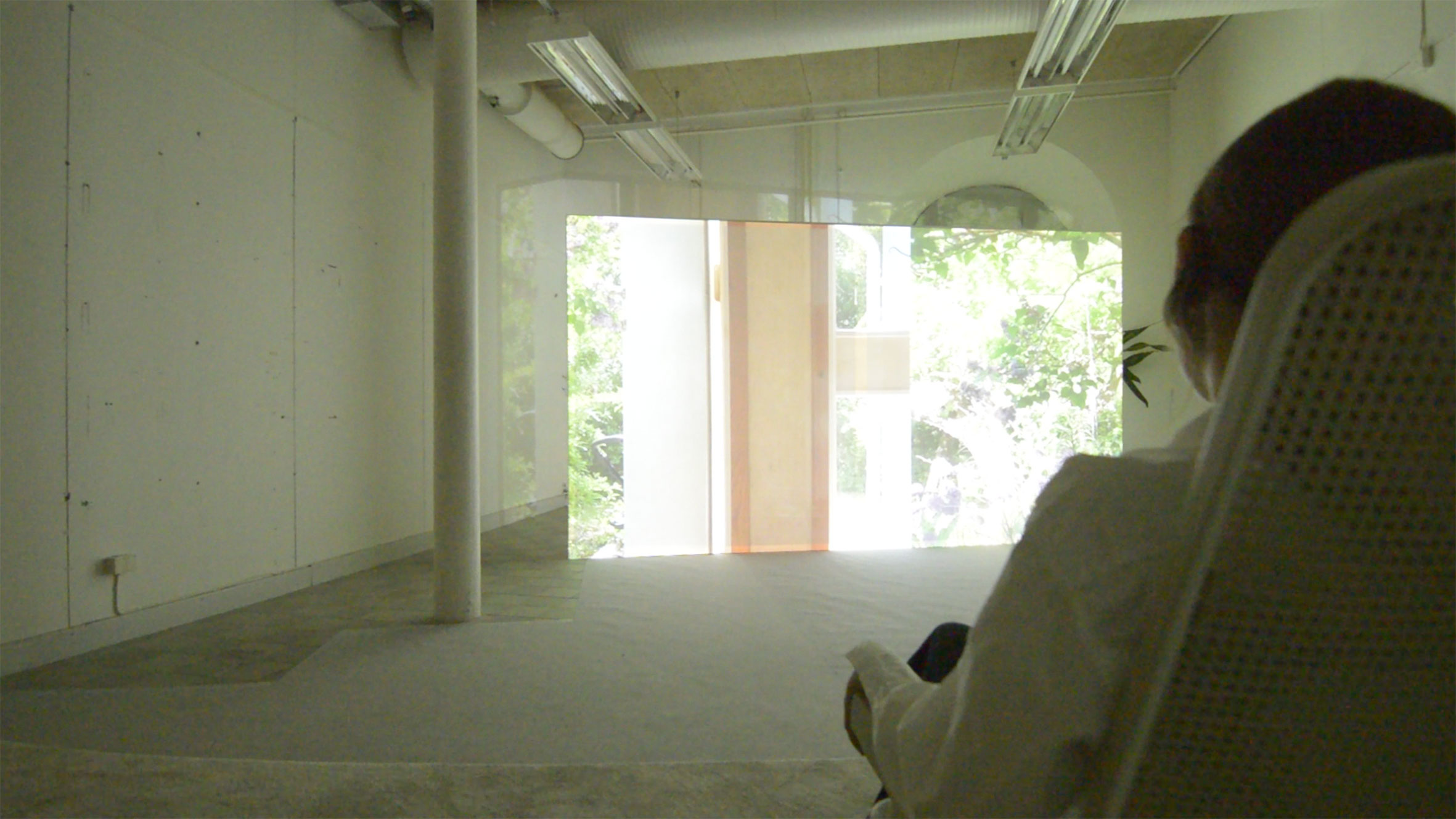


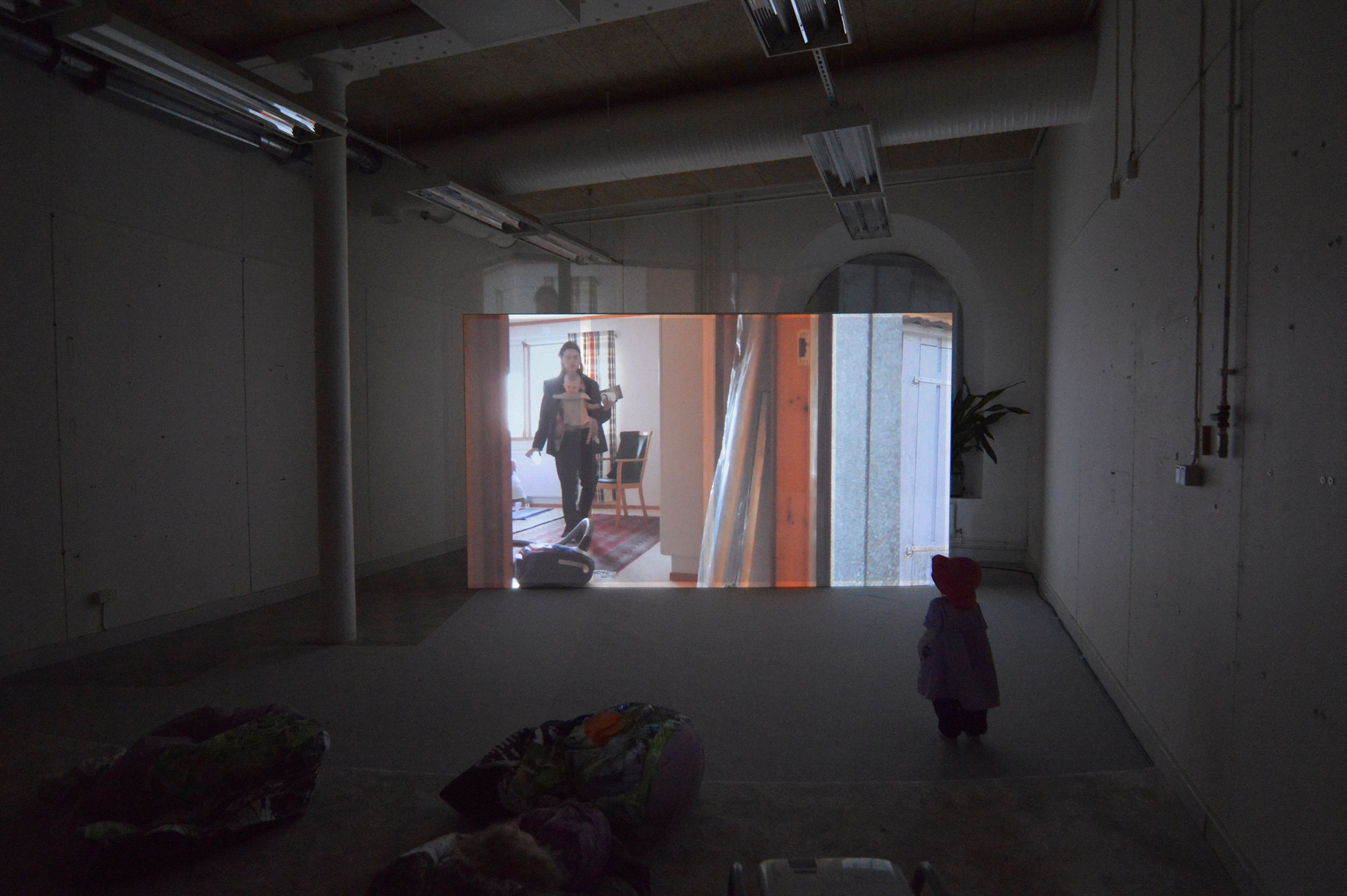

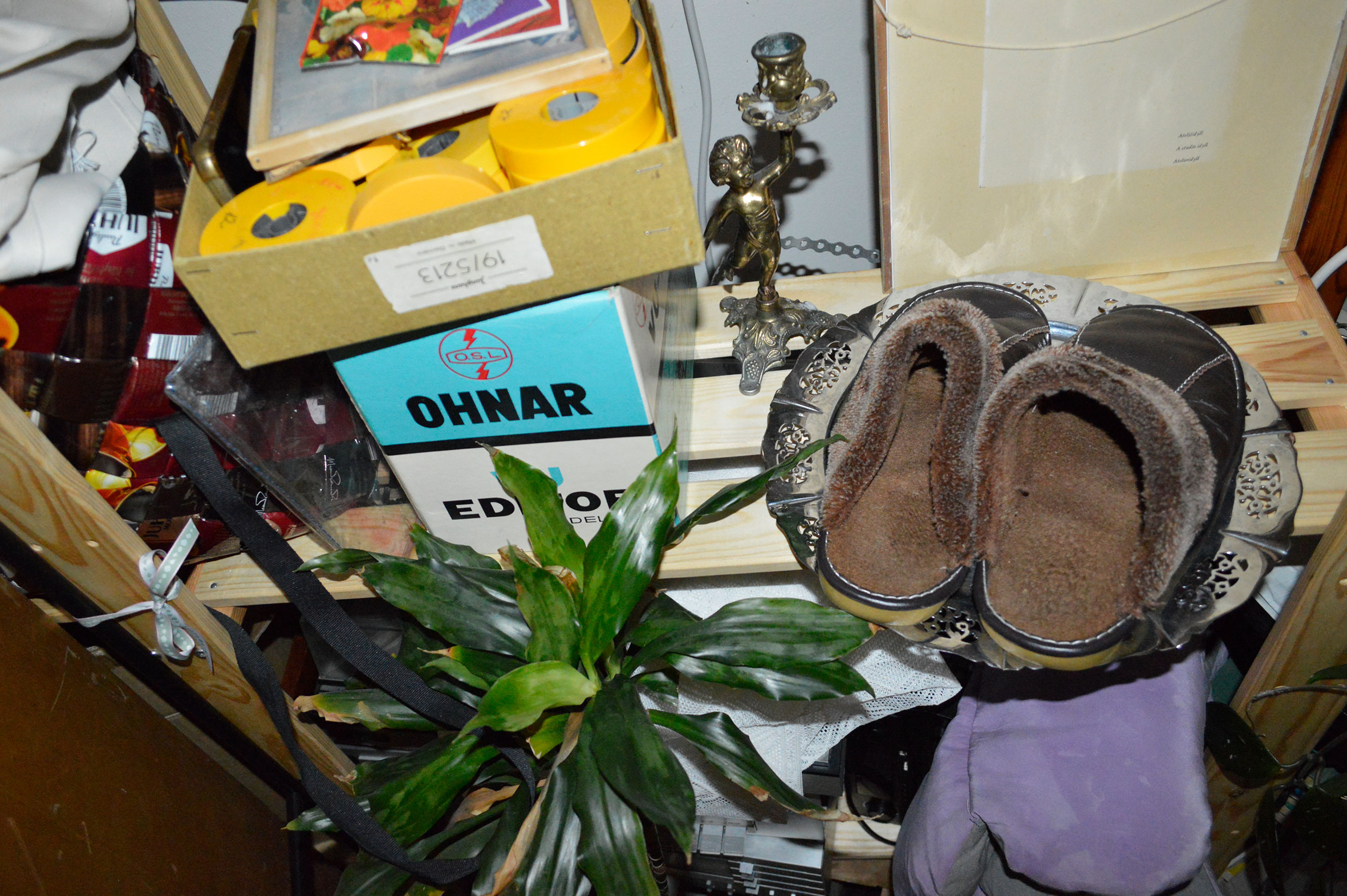
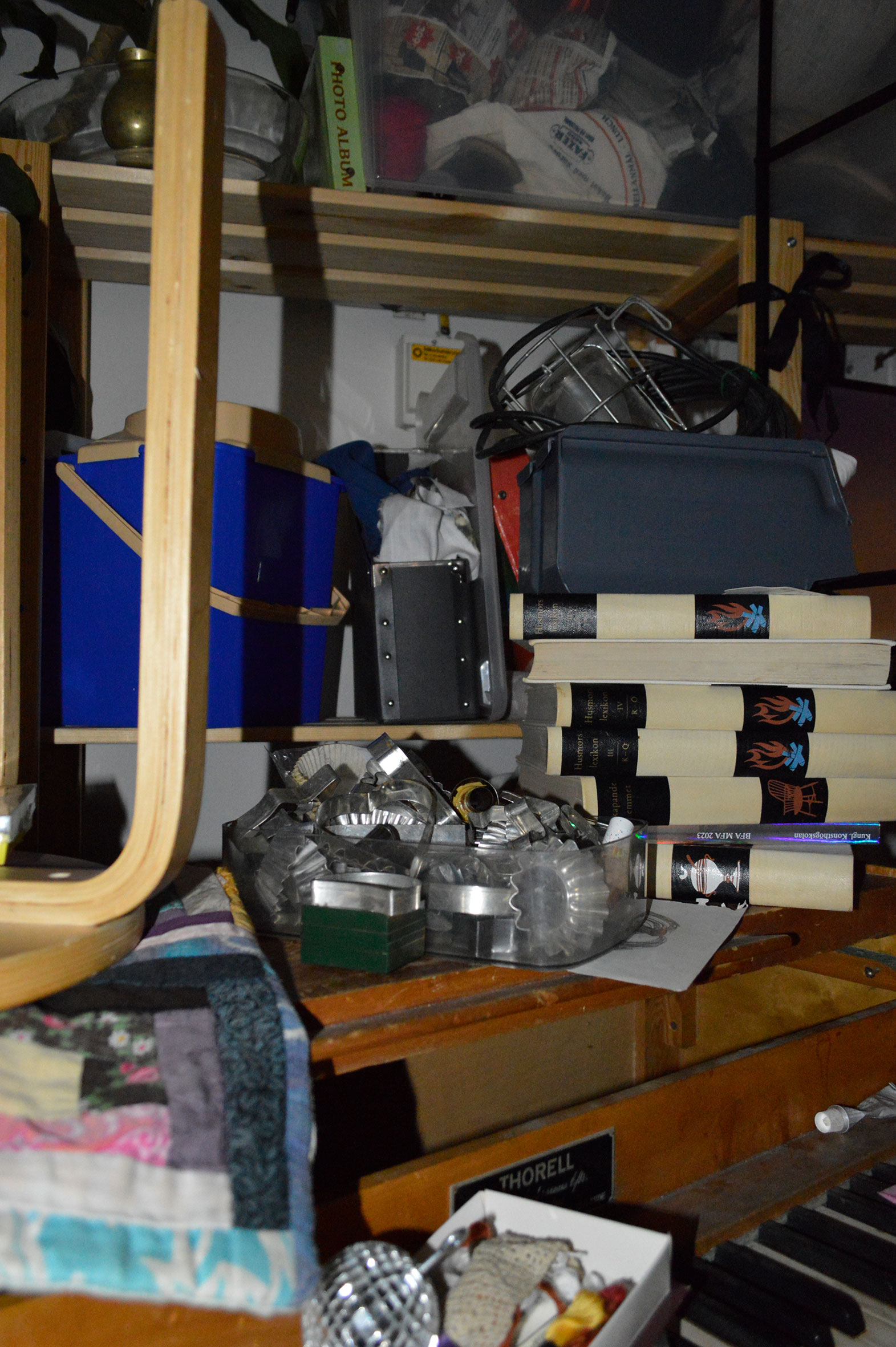
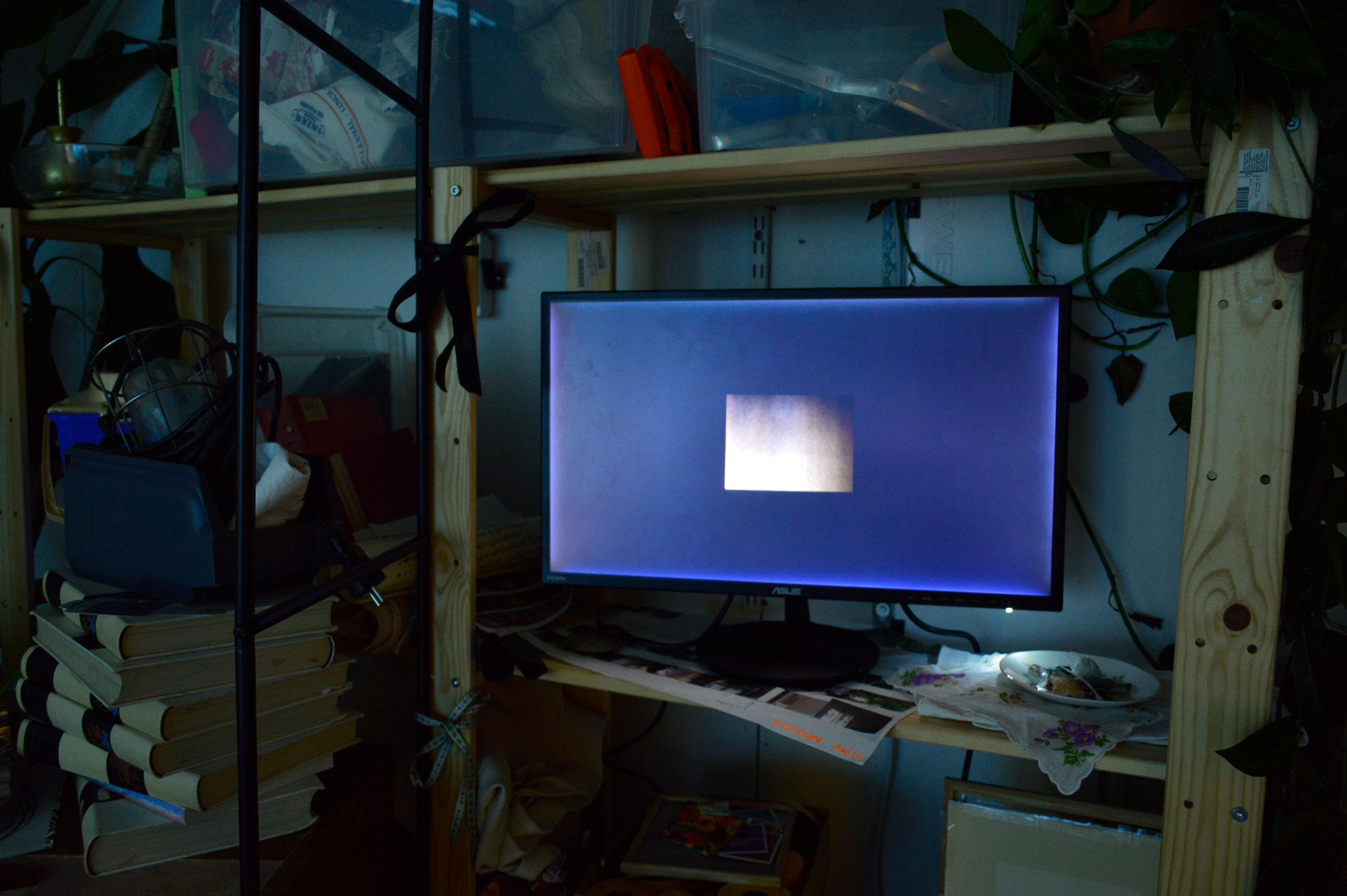
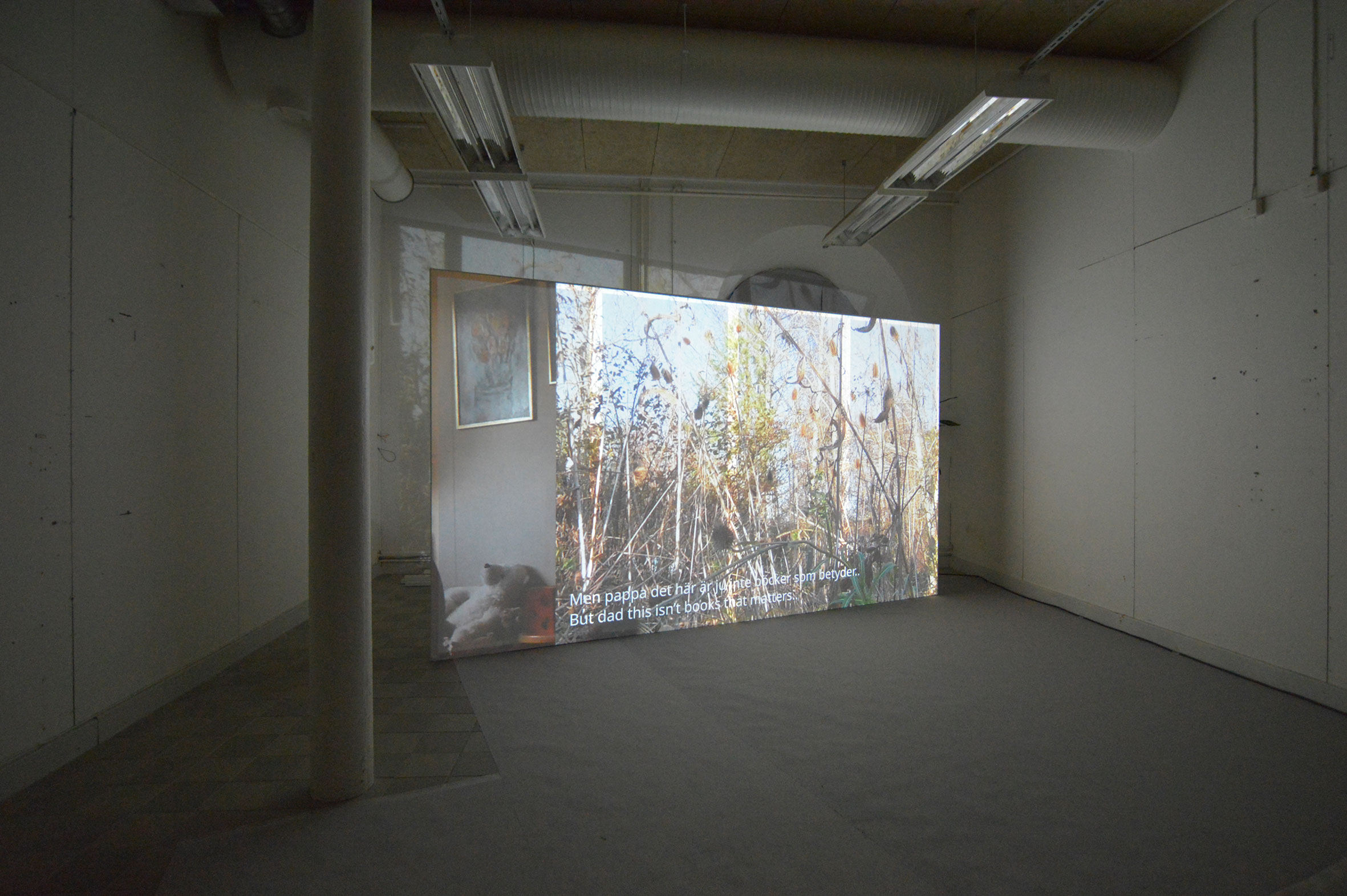
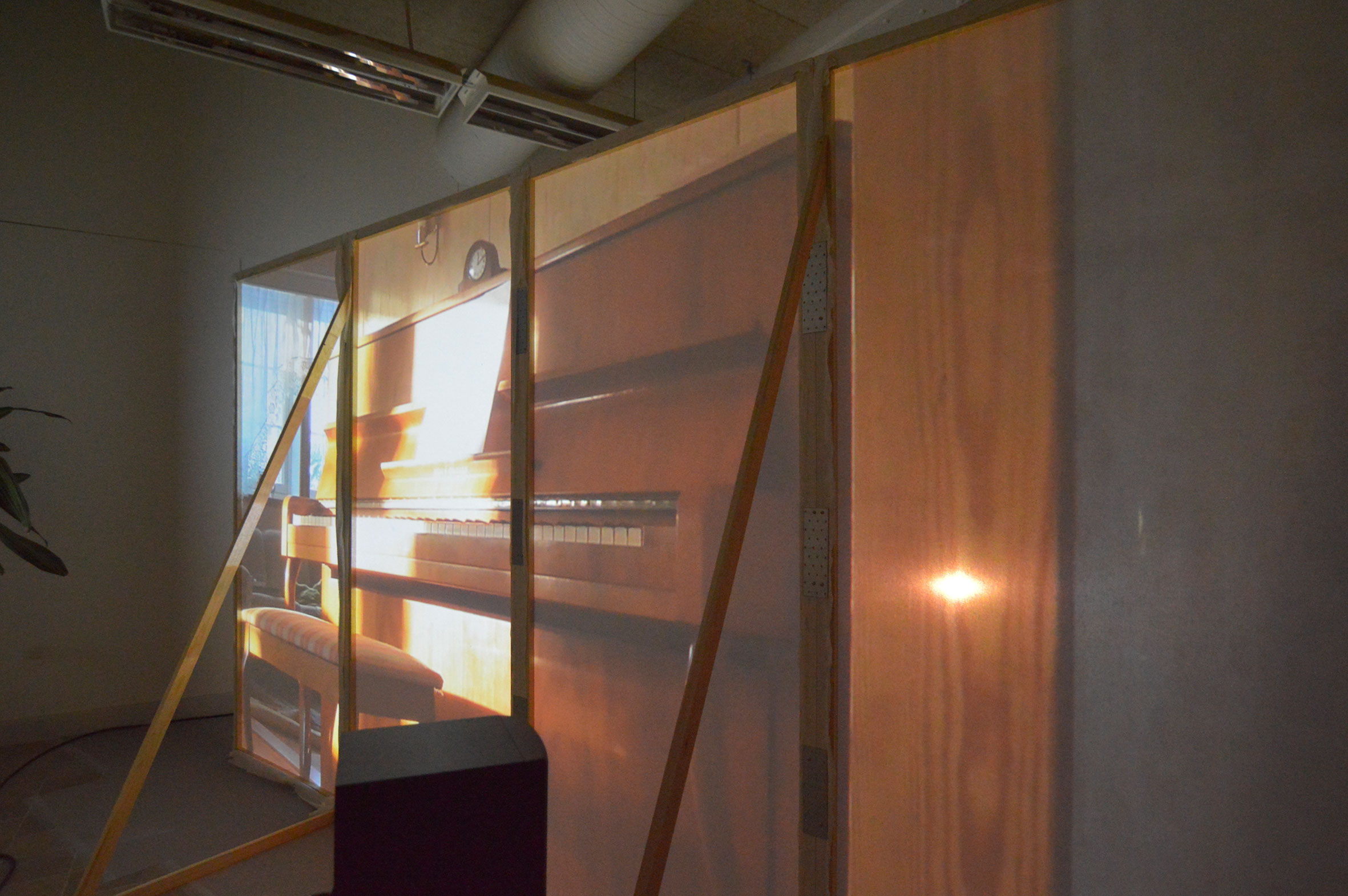
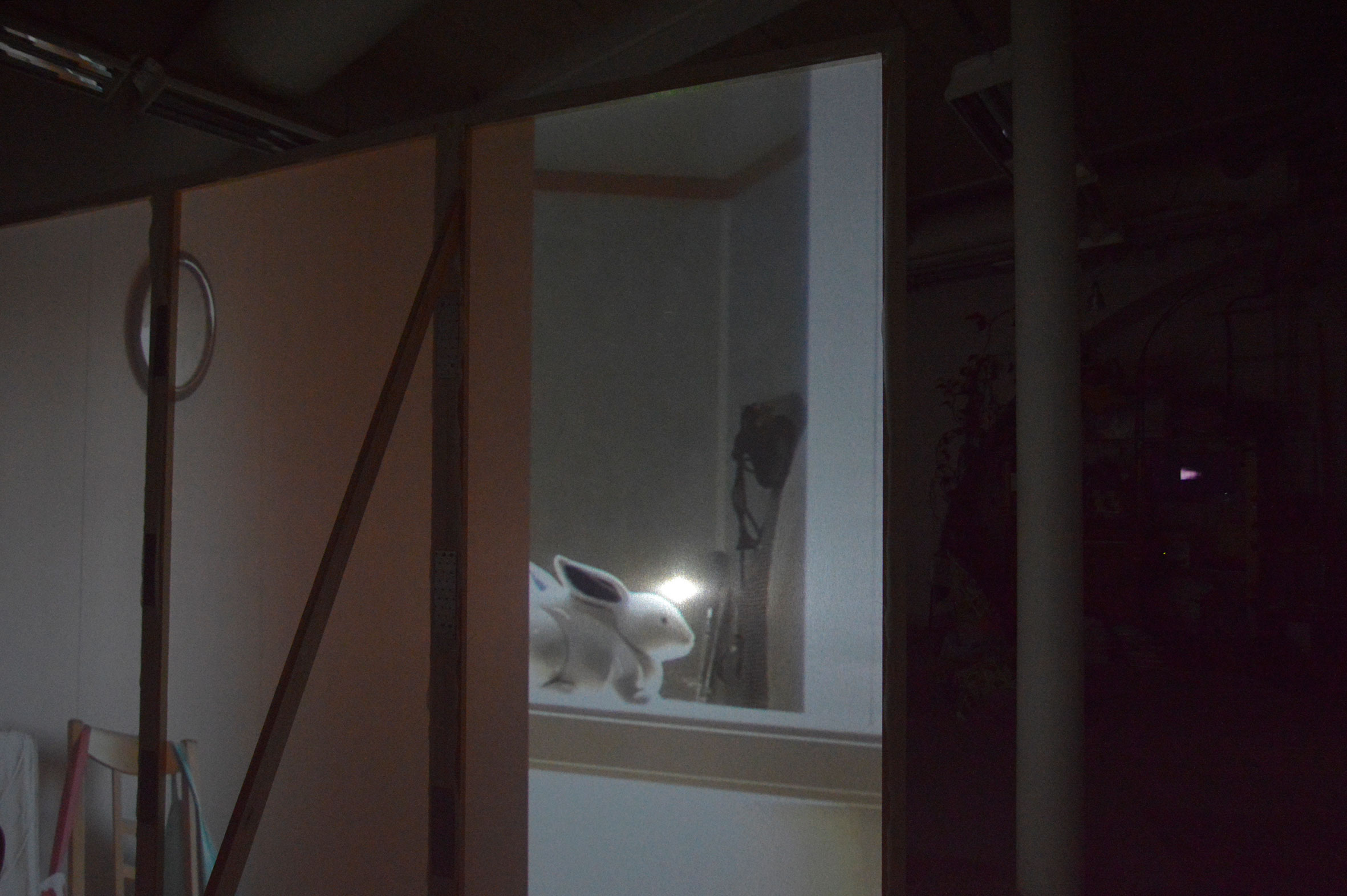
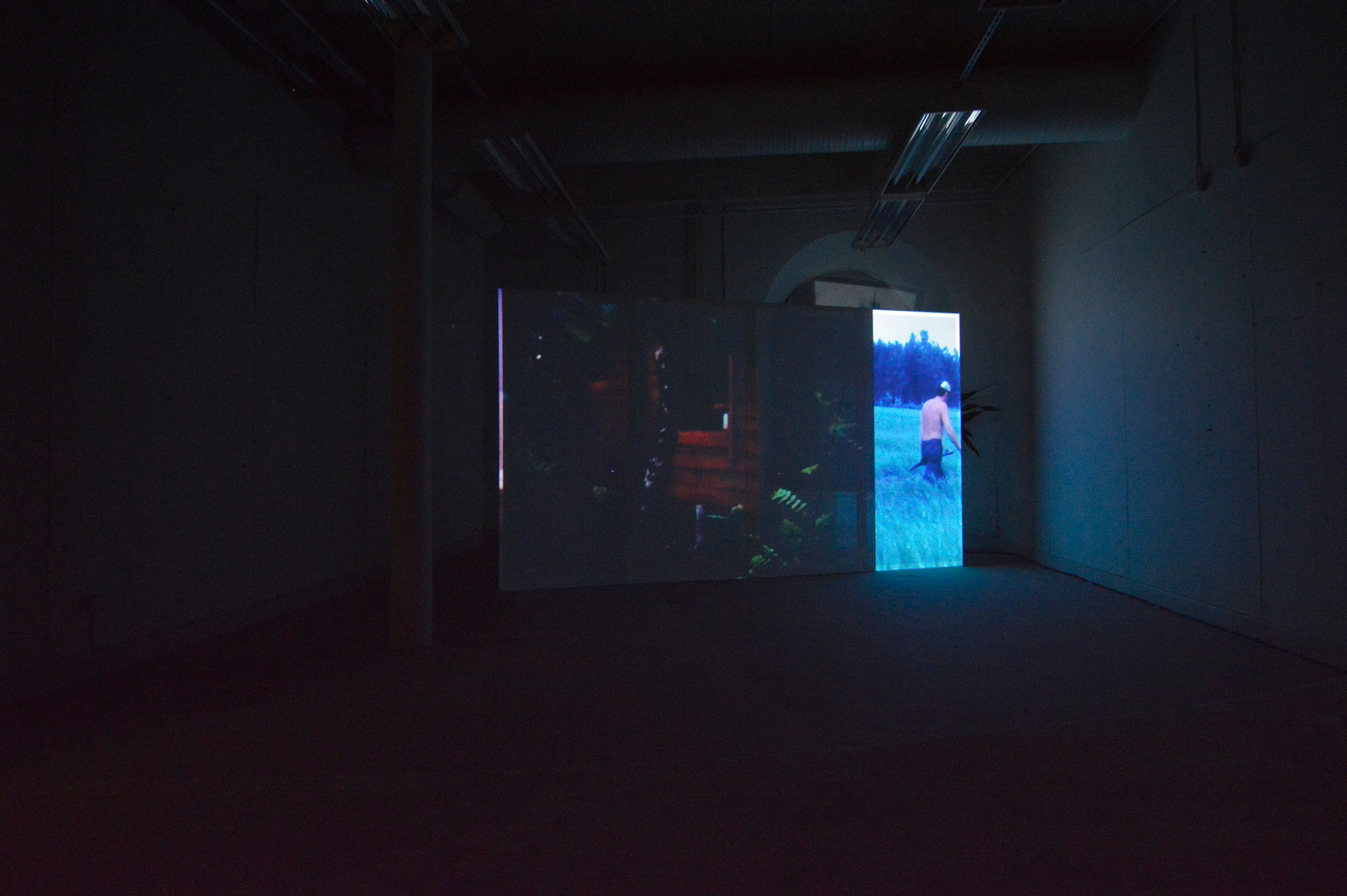

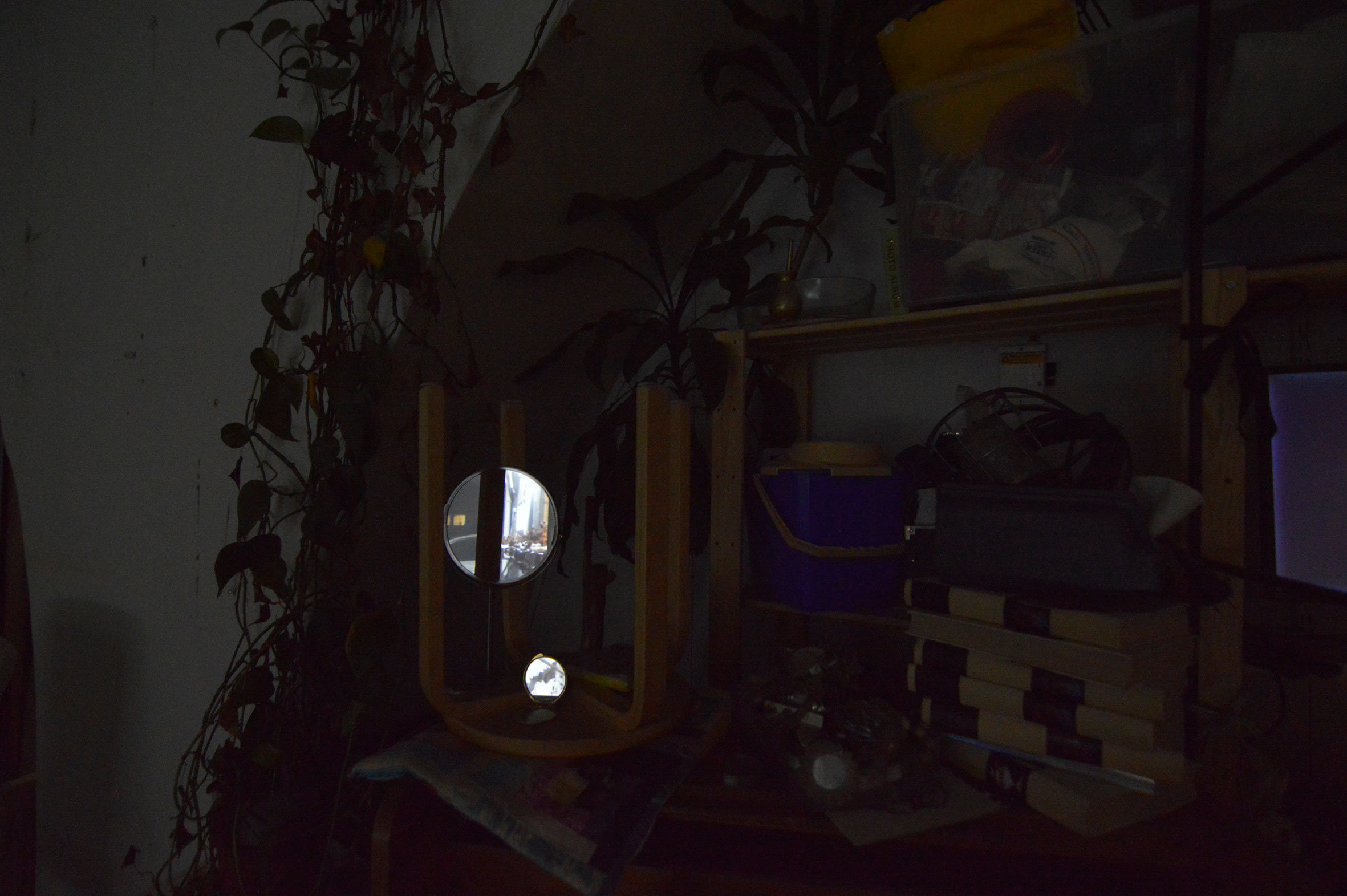



The installation was built in a newly emptied storage room for tech equipment at the Royal Institute of Art. I was interested to work in a space with its own personal traces, like if caught in an in-between - about to move in or out? I covered parts of the floor with a paper often used during renovations, and placed a soft carpet on another part for its domestic and welcoming quality along with garden chairs. In the back of the space I built an installation with props from my grandparents home, as well with objects from the original space. Here I placed a screen with the sibling piece Ljusår that consits of my grandfathers Super-8 recordings viewed from the monitor of a Vu-Editor, while its beeing scrolled through. The main film was projected on four connected screens covered in thin cotton, letting the construction shine through and the image to bleed out and reflect the surfaces behind and above it.
Camera & Editing Sofia Romberg
Super - 8 Sture Romberg
Text Animation Rahul Gunnarsson
Sound Design Jon Lennblad & Sofia Romberg
Special thanks to my professor Ming Wong & the input from the student group of performance in the expanded field at the Royal Institut of Art during this process, aswell the awing technical support from Caio Marques De Oliveira and Astrid Braide Eriksson <3
Wildflower Tales
Film & Installation
06:24 min loop
2024-2025

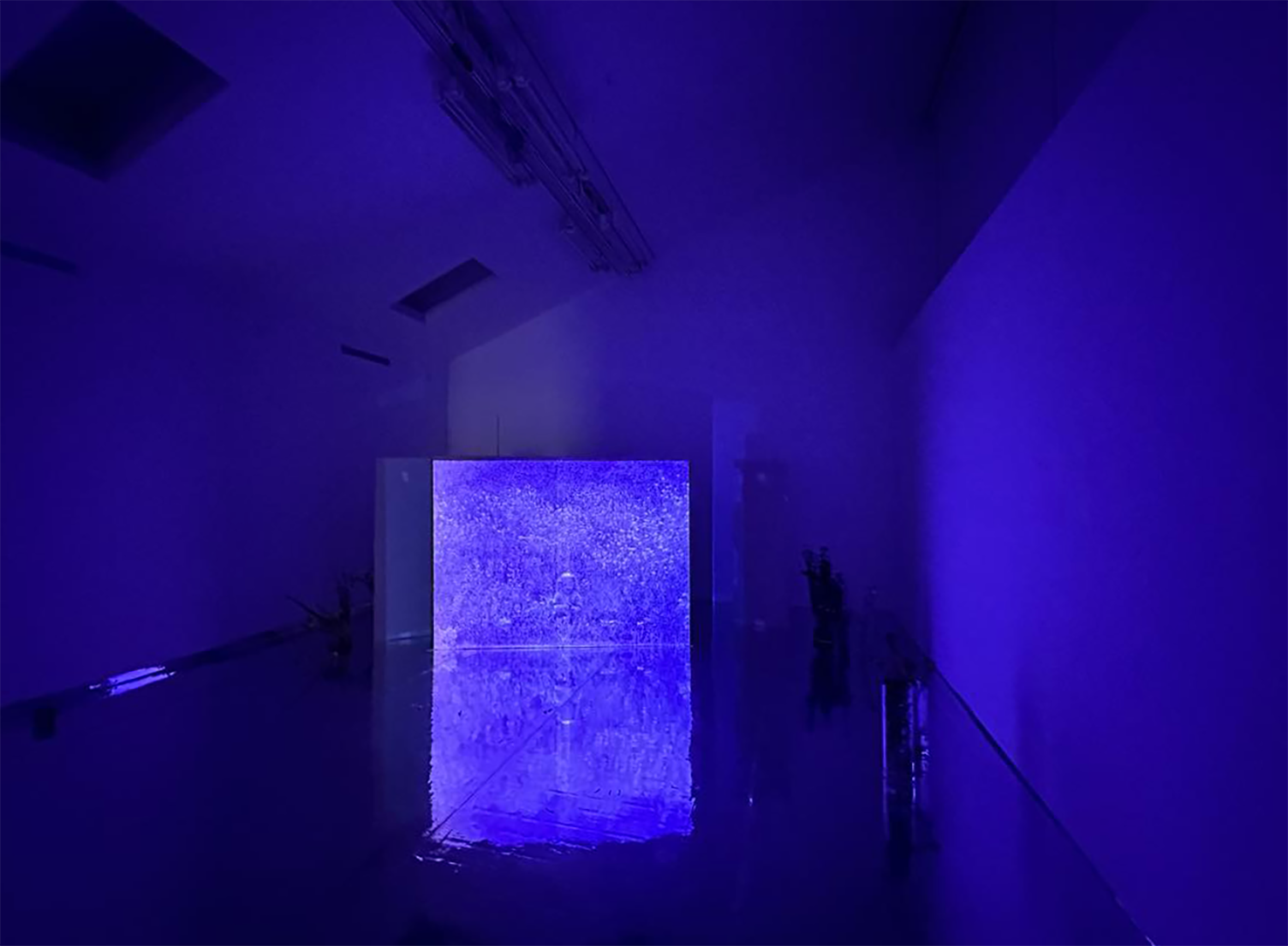

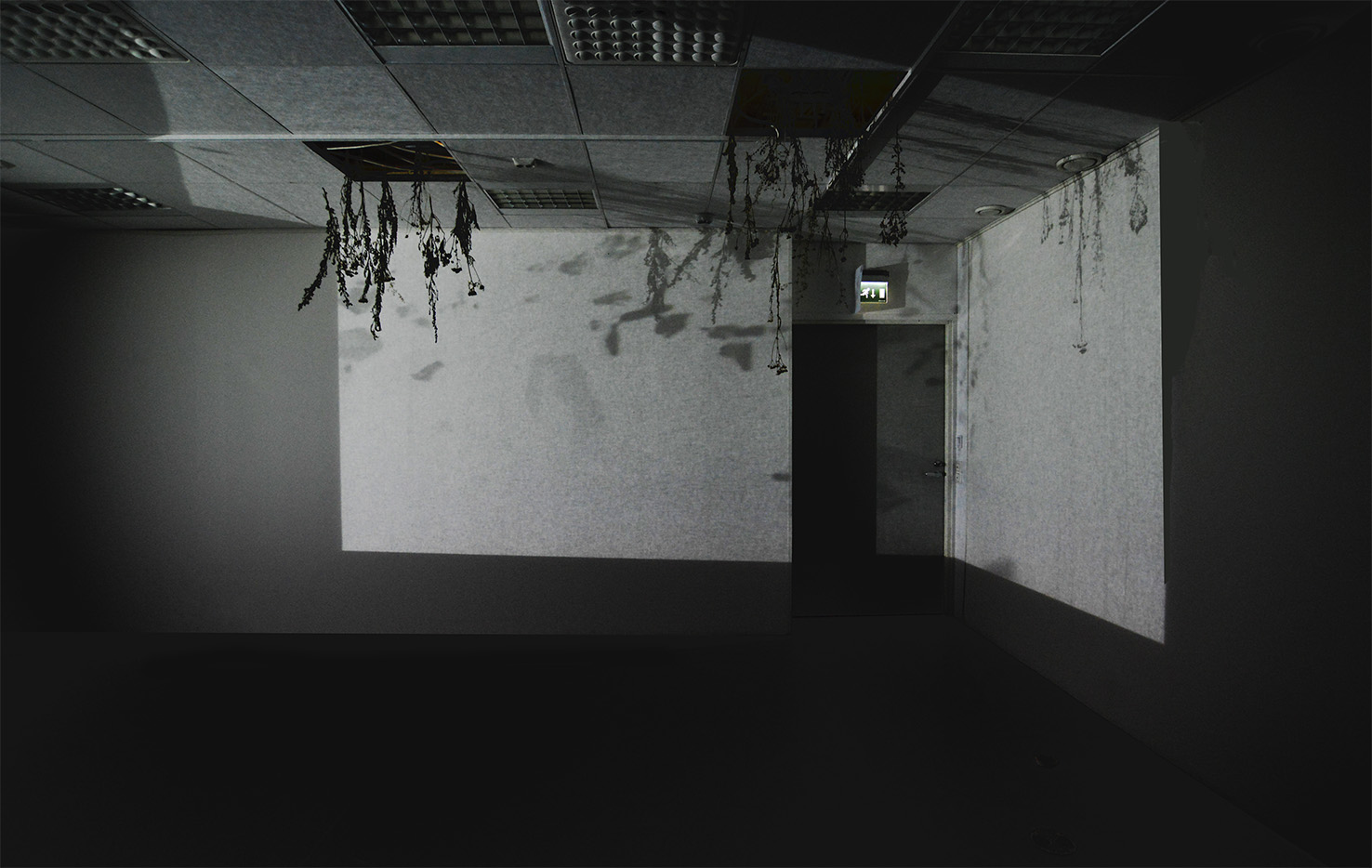
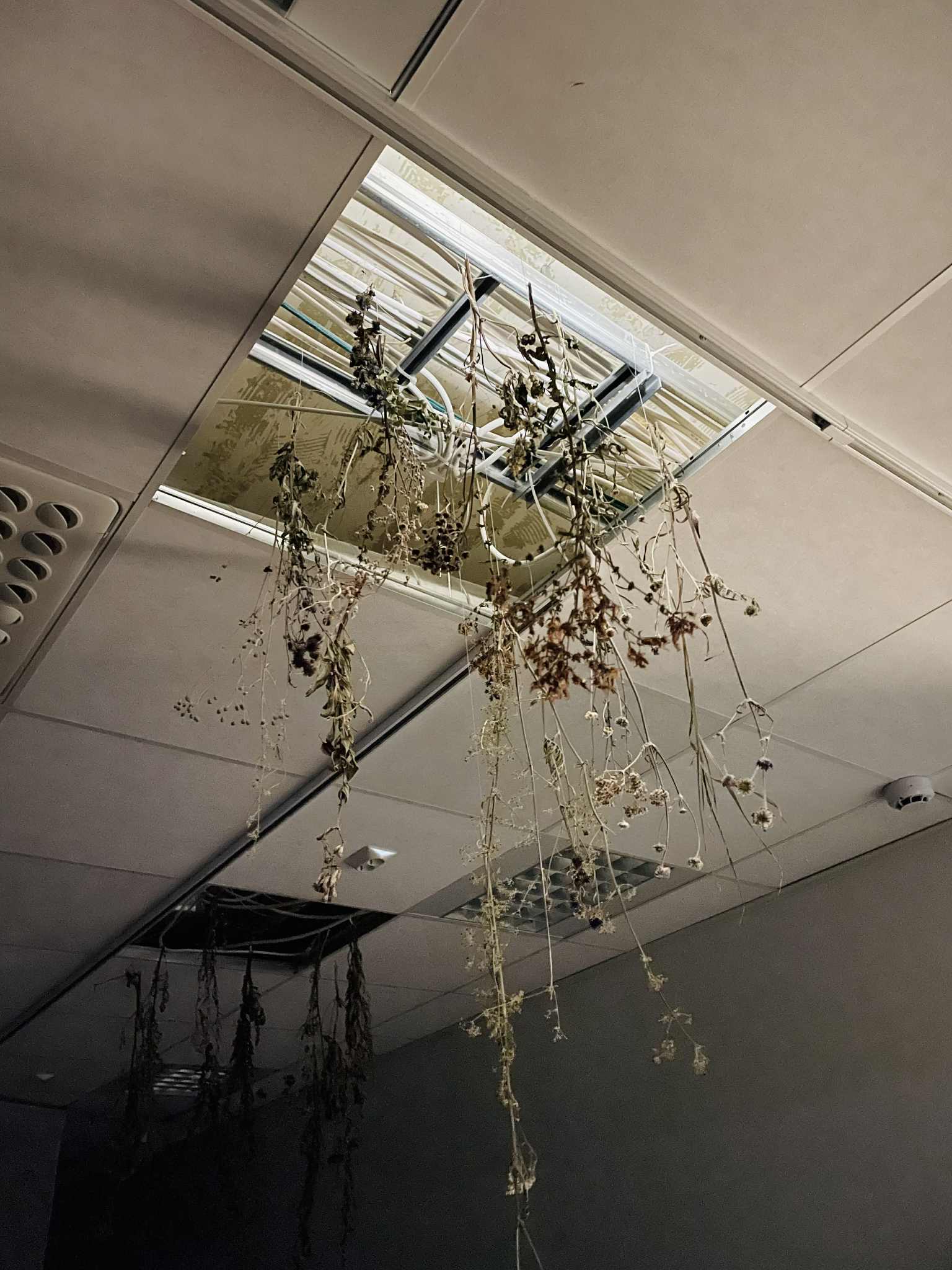
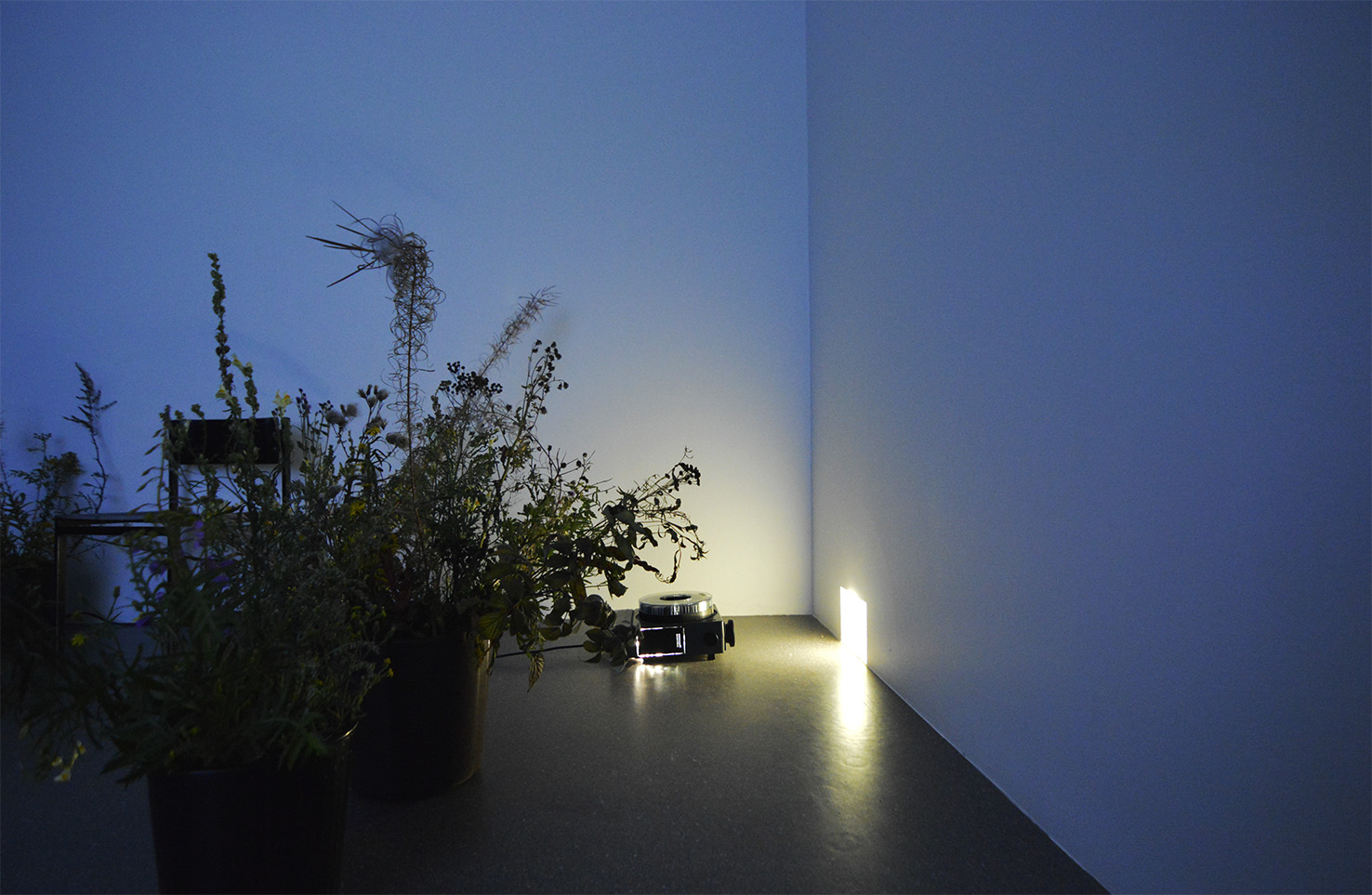


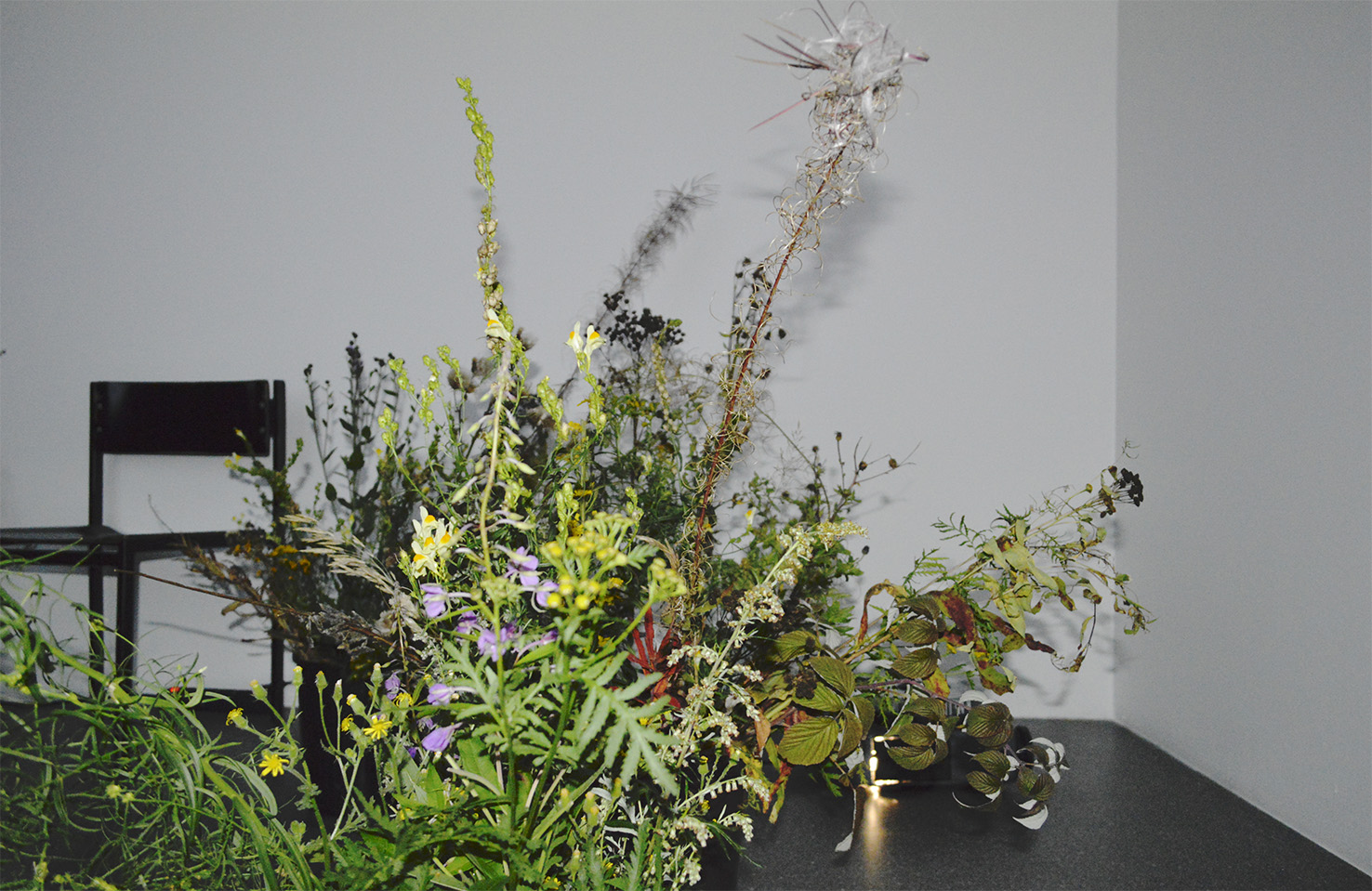

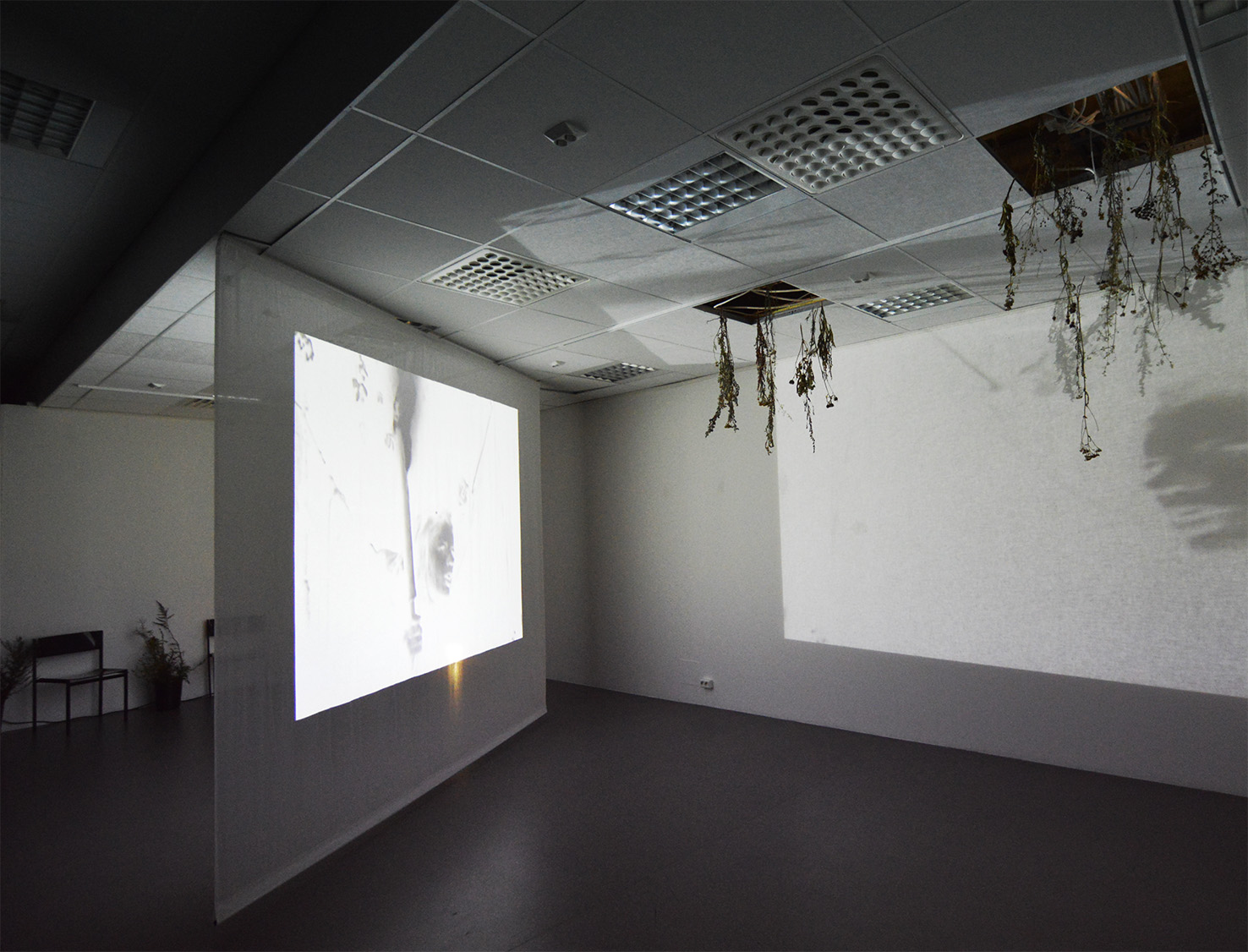



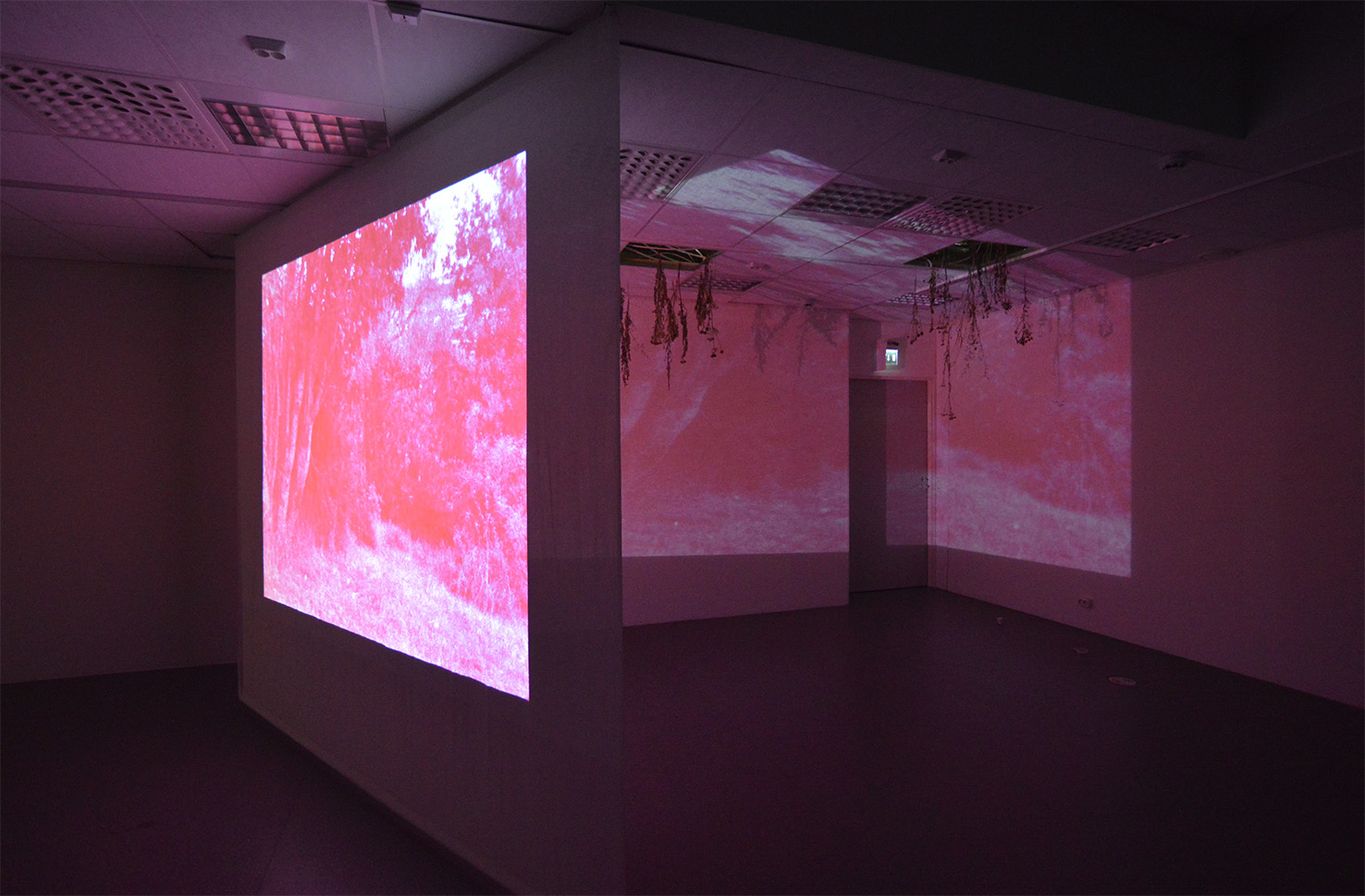
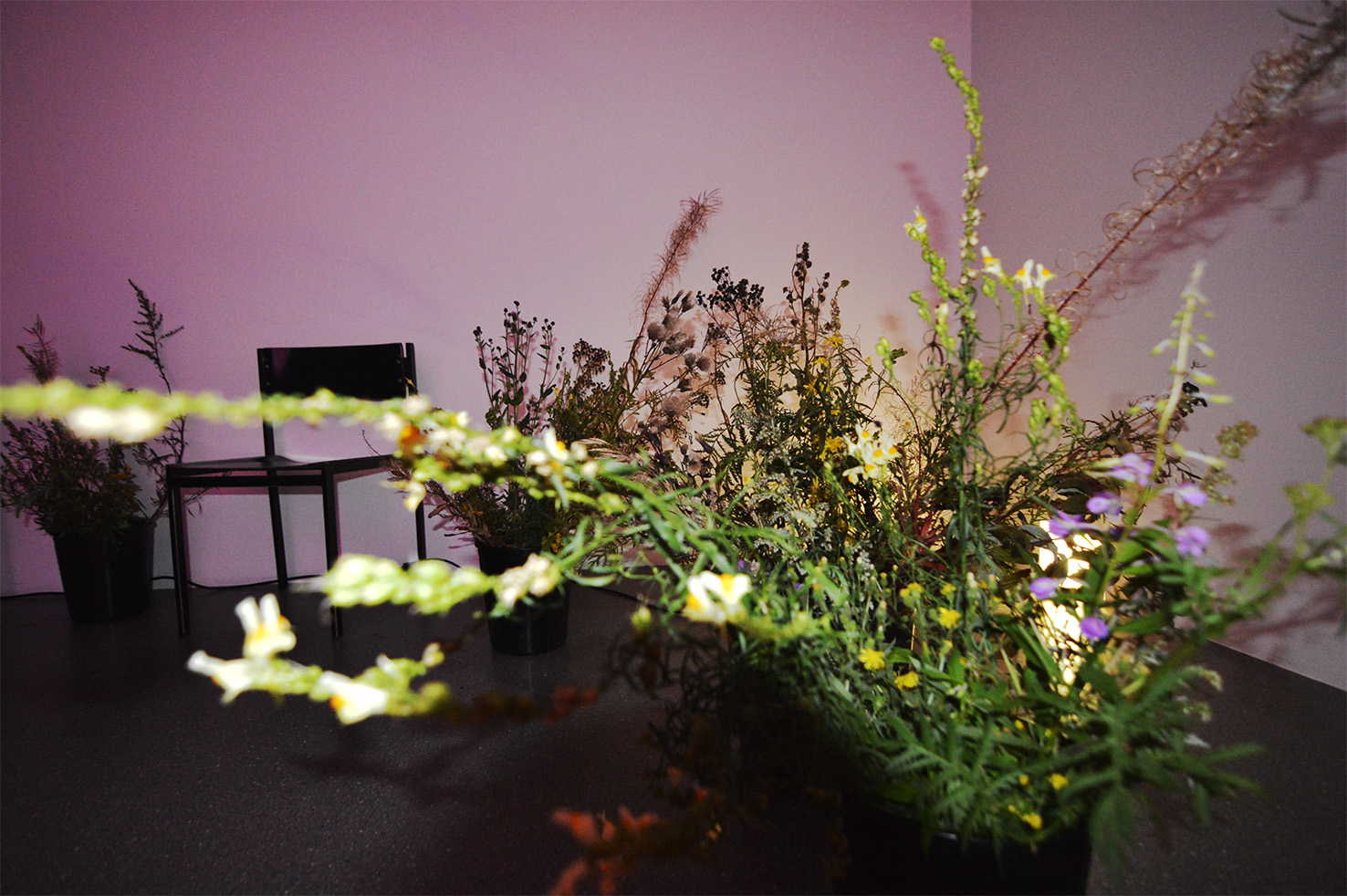











In the 1960s and 70s a demolition frenzy took place in Stockholm wiping out large parts of the city center. This was a time with social and urban transformation en masse. Conflicting visions about a future in plural.
Suburbs grew up at the outskirts where everyday life would play out. In Vårberg, two artificial mountains were placed, designed to resemble an amphi theatre. They were built of the demolishing material from houses, blocks and blowouts from the expanding subway system. Its nickname became The Vårberg dump. The soil that covered the massive piles came from many directions. A flora that was versatile originated with time, just like the area itself where people from over a hundred nationalities live today.
Wildflower Tales is shot with 16 mm film and processed by hand with flowers and plants from the filmed locations on the mountains. A document of short scenes with landscapes, flowers, family and friends in simple poses sweeps by, linked with what became the culmination of further blunt transformations in Stockholm this time around, the riot in Kungsträdgården 1971.
A common quote from the urban planners in the 60s was the aim to create a new city for the new man. Decades later here we are, man and nature caught in-between opposing forces in a milieu both created and suppressed. It’s a wildflower, is a flower, is a flower.
Camera Vladyslav Kamenskyy
Archive Footage Filmligan, 1971
Plant developing / editing / sound Sofia Romberg
Scanning Mutascan Service, Helsinki Installation images from my solo exhibition at Galleri Mejan 2024, The MA-group show at Konstakademien 2025 (Photo: Jean-Baptiste Béranger) & from my solo at Fringe in Vaasa 2025.
In each installation I have assembled materials from the local site with discarded once, like the mirror dance carpet from the Royal Opera, 1970s. & combined the organic with the fabricated.
Special thanks to my professor Tris Vonna Michell & the input from the student group of performance in the expanded field at the Royal Institut of Art during this process. Love to Caio Marques De Oliveira, Vladyslav Kamenskyy, Mikael Beckman Thor, Daniel Norrman, Björn Larsson, Jenny Nordmark, Åsa Andersson Broms, Liv Strand for additional feedback and artistic guidance!

Svenska för er
Image Slide 07:17 min (loop)
2020
20 years old my grandmother Reetta Aulikki (Haapamäkki) Romberg (1931 - 2018) came to Stockholm. A farmer girl from the Finnish rural area who found a job as a factory worker at Marabou Chocolate AB. When she passed away we helped out to sort through her remains. Affected by war and careful upbringing, throwing away things were never part of her world picture and many of the proofs of her existence were stored in boxes of all sorts, often chocolate ones given that also my grandfather worked in the same business as a truck driver for another brand. This piece links to my interest in human traces and how to tell stories about ourselves and others via personal archives.
Image Slide 07:17 min (loop)
2020
20 years old my grandmother Reetta Aulikki (Haapamäkki) Romberg (1931 - 2018) came to Stockholm. A farmer girl from the Finnish rural area who found a job as a factory worker at Marabou Chocolate AB. When she passed away we helped out to sort through her remains. Affected by war and careful upbringing, throwing away things were never part of her world picture and many of the proofs of her existence were stored in boxes of all sorts, often chocolate ones given that also my grandfather worked in the same business as a truck driver for another brand. This piece links to my interest in human traces and how to tell stories about ourselves and others via personal archives.
In this version I scanned 86 pictures and objects while letting the surface get exposed to different amounts of light from the outside.
The title (Swedish For You) refers to her swedish-finnish dictionary by Swedish Radio from 1955.



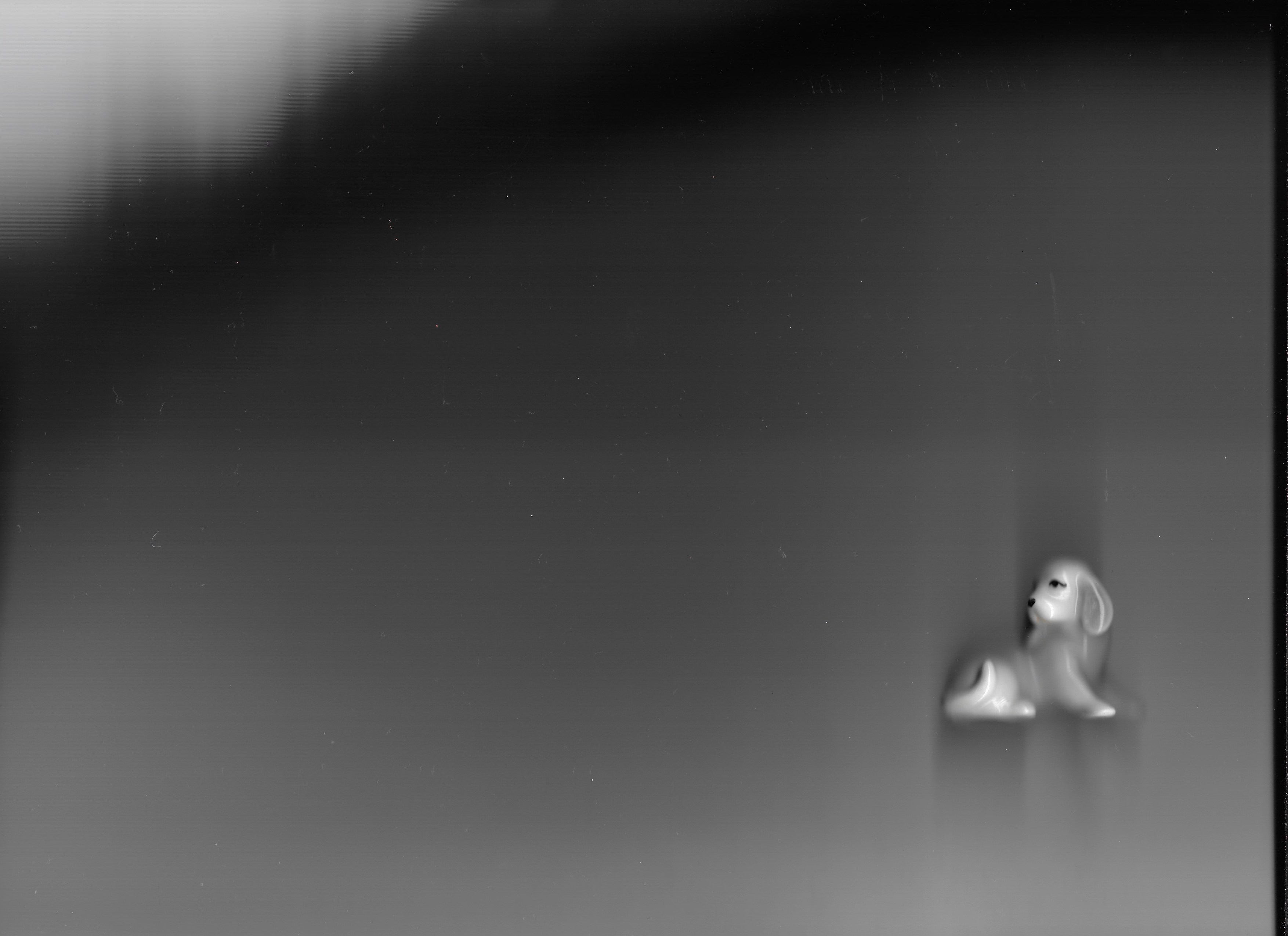
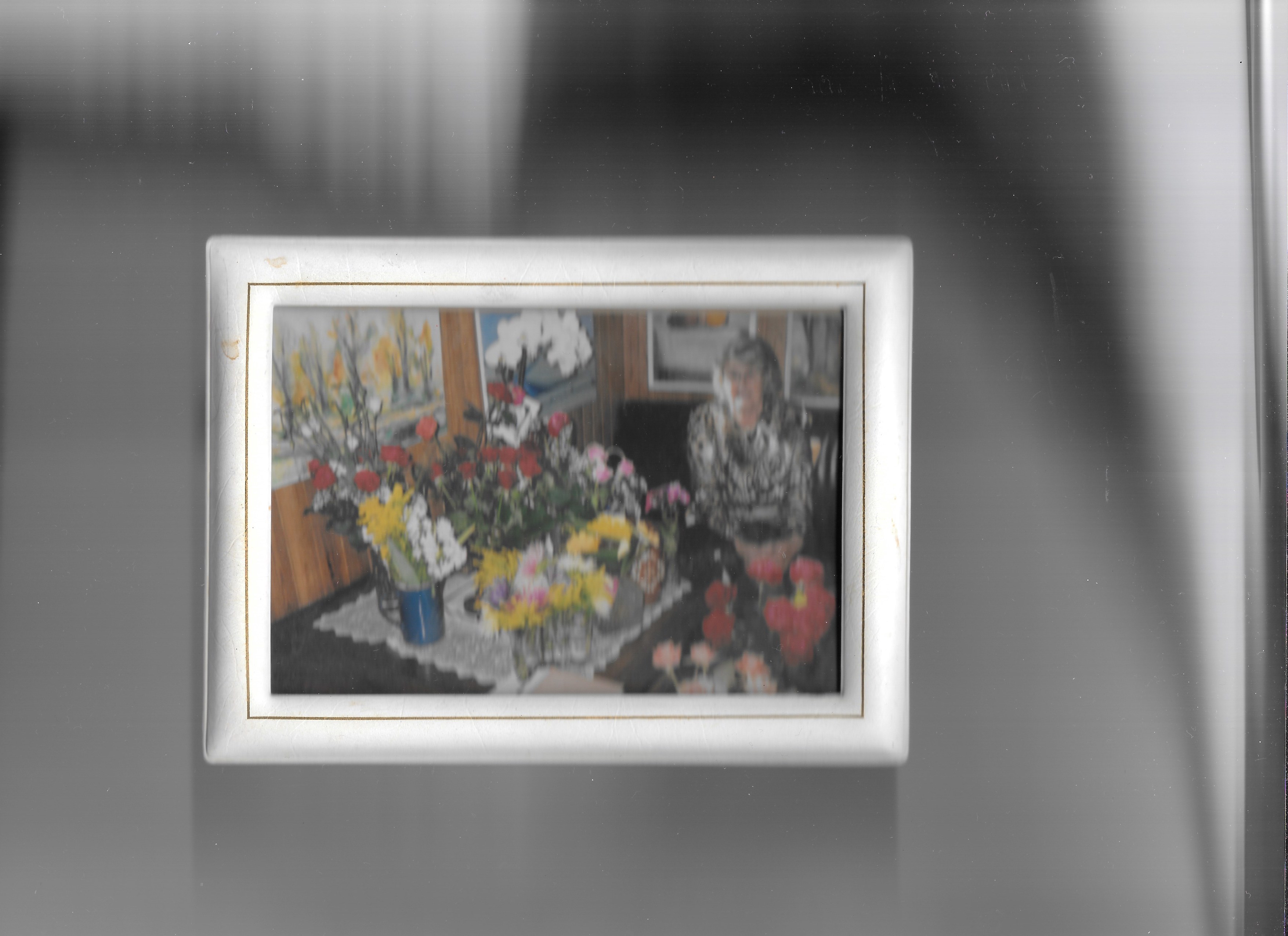


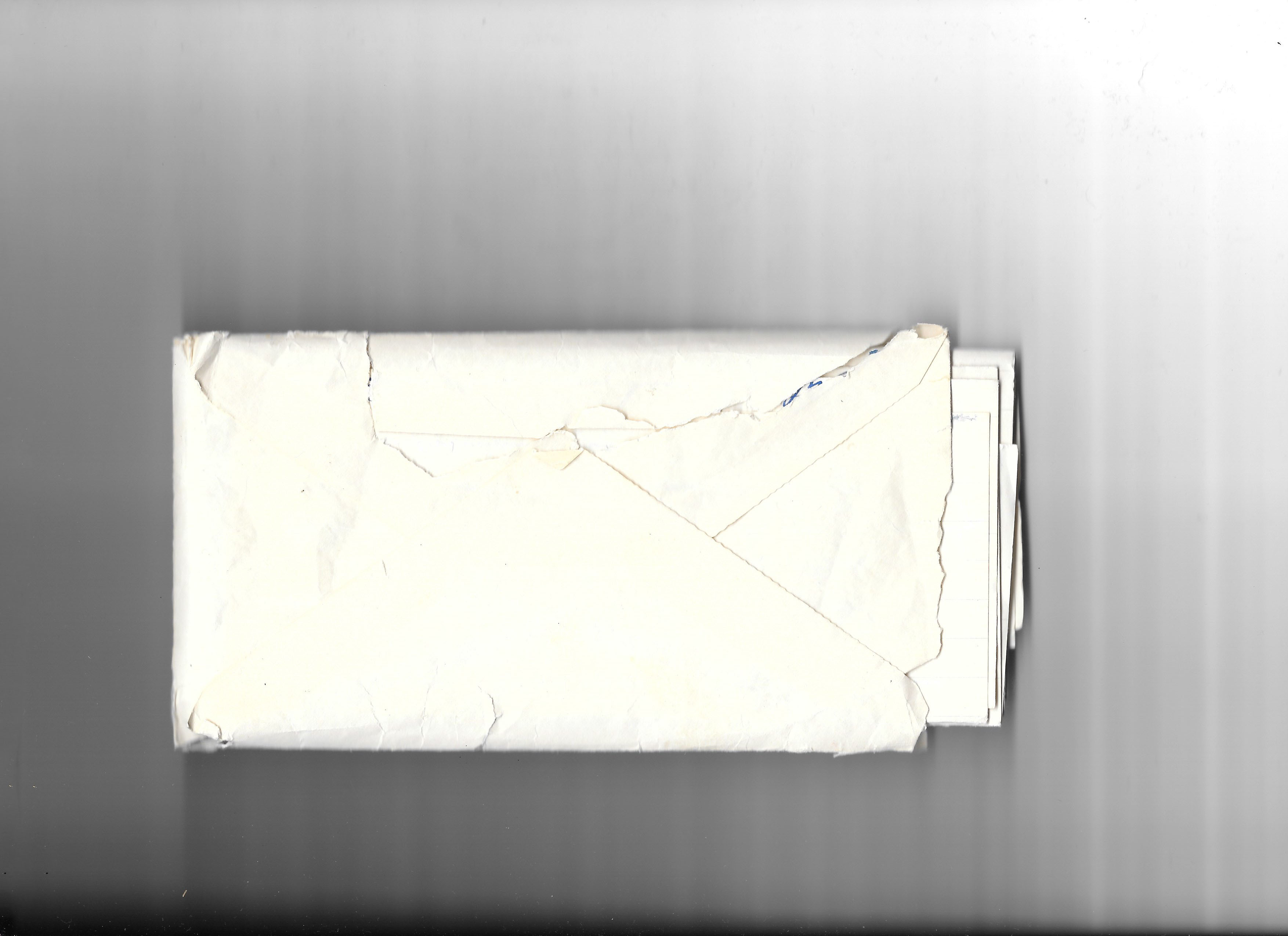



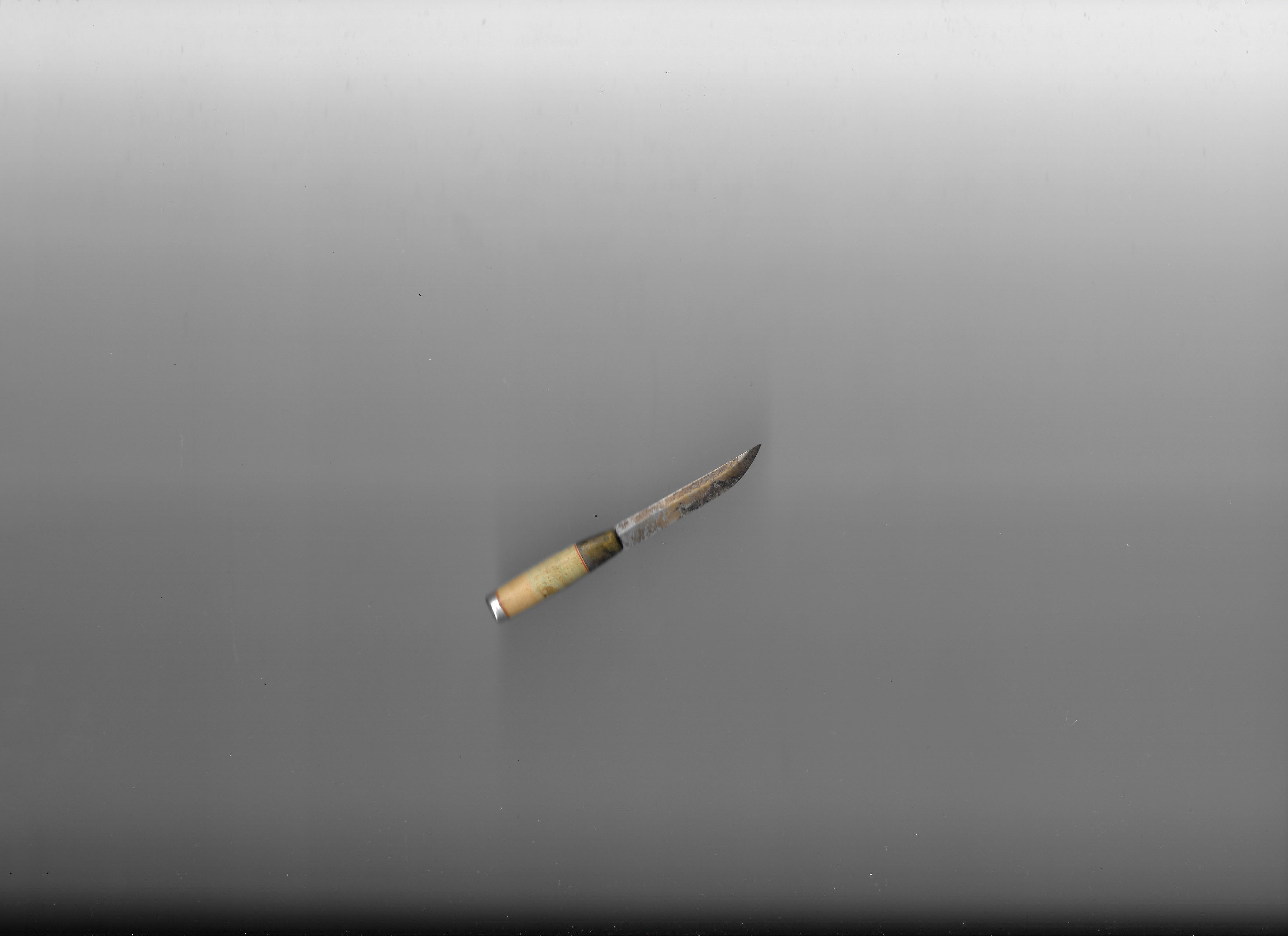


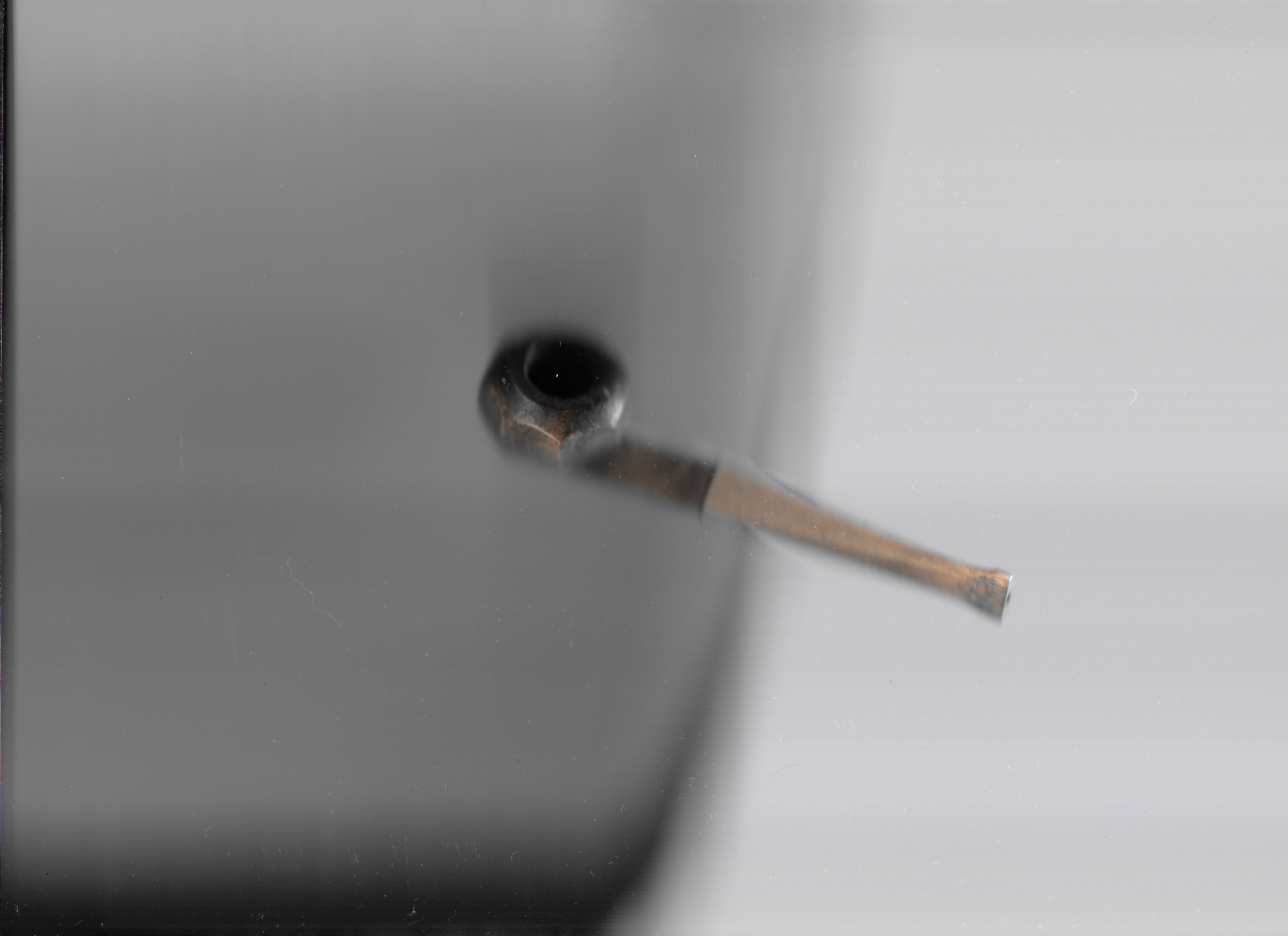

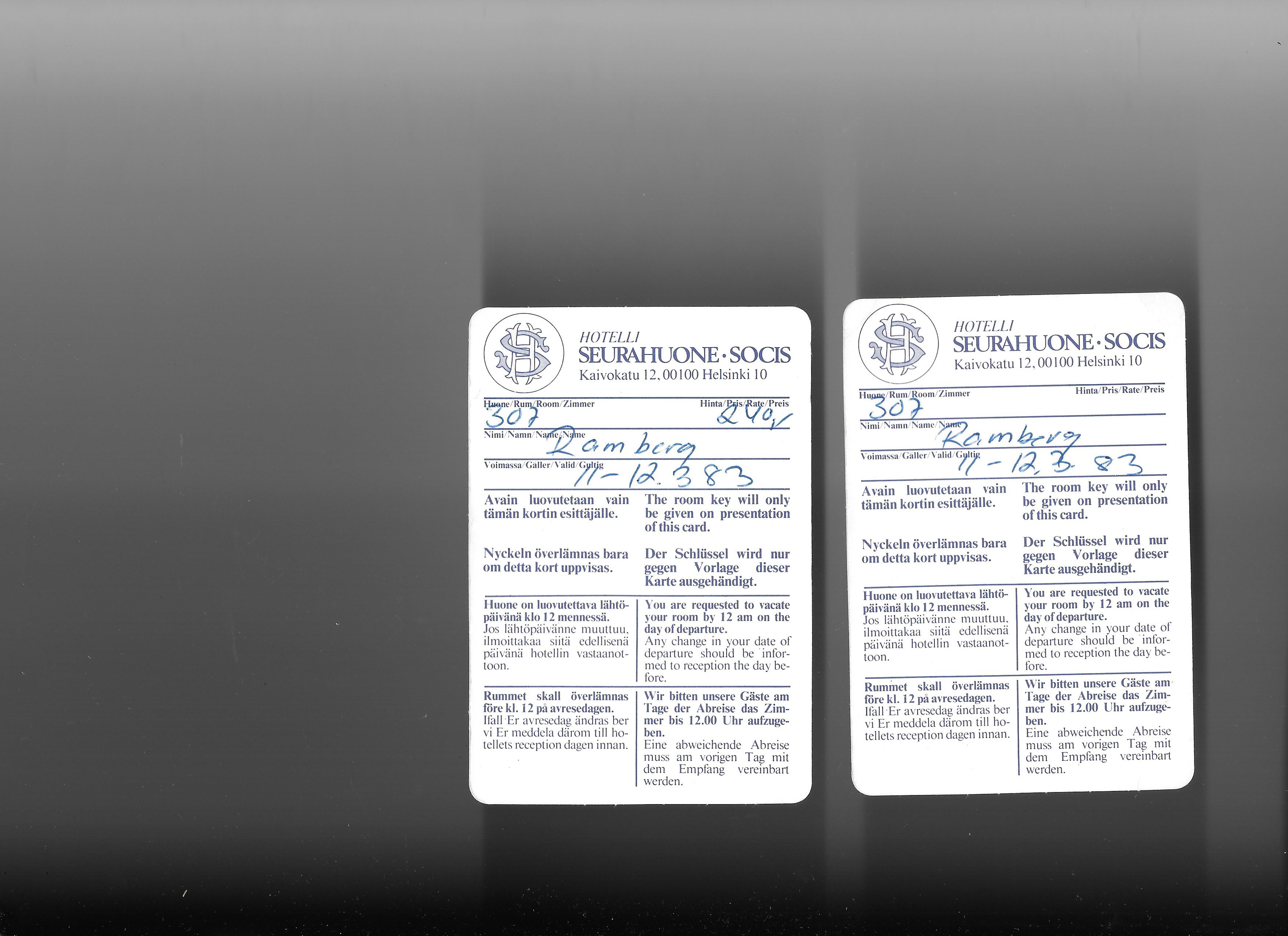
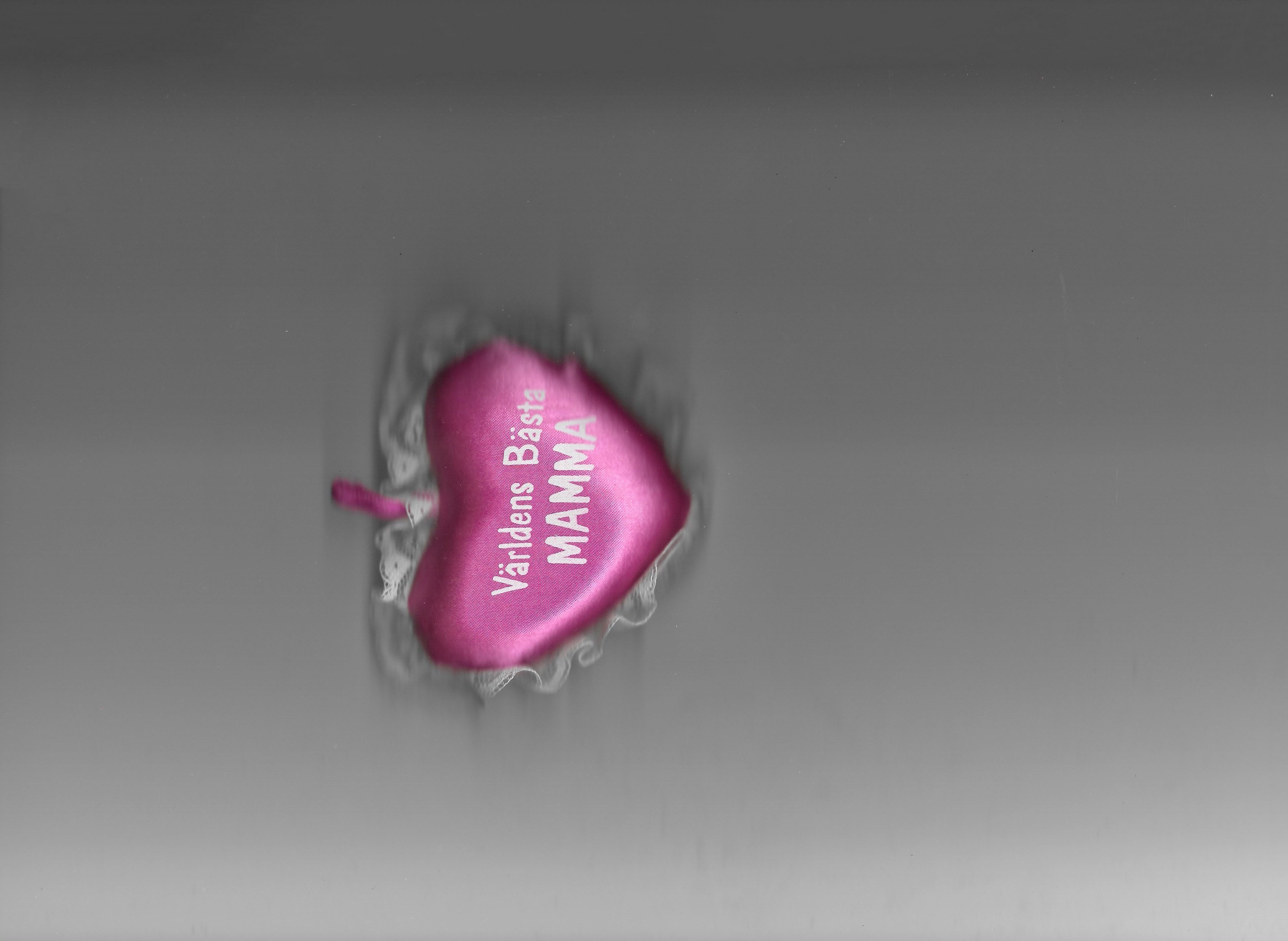


ARCHIVE
2013-
Digital Collages, 2023 -



In these works I am looking at archive footage from the Internet Archive.
A lot of the material I am scanning through deals with educational topics, sharing the excitement when you are about to embrace something new. This has also coincided with my interest in the beginning of moving images techniques, especially the phenakistiscope (1833), the first widespread animation device that created a fluent illusion of motion when facing a mirror. In my version your eyes follow the small transformations in the motive, imagining the motion.
The title refers to Ray Bradbury's novel Something Wicked This Way Comes from 1962.

Ljusår (Light-years) is a sibling work to the film House, Garden and So Forth Beyond and consists of Super-8 footage from my grandfather's personal recordings viewed from the monitor of a Vu-Editor, while it's being scrolled through. The duration of the work is interpreted from the time it takes for the light to travel between sun and earth.
Time Strollers / Port as in portal
Film & Walk 2020
Part of the collective virtual & live group exhibition Connecting Georgia (2019-2020) hosted by Intercult. An artist-led project exploring post-industrial waterfront heritage in the context of urban planning and community development, connecting the city of Batumi with other European cities. I was invited by SIMKA (Karin Lind & Simon Häggblom) to make a site-specific work connected to the path between Slussen & Londonviadukten, Stockholm.
I conducted many walks back and forth during the week we worked, giving myself different tasks of walking, looking, listening while making memory notes after each walk. I then made a montage of some of these texts together with quotes from Walter Benjamin's writings regarding the flaneur, read by an AI voice. During the opening I also invited the visitors to perform silent backward walks with me.
Link Intercult >>
![]()
Participants from Stockholm -
Oskar Gudéhn, musician och architect
Felice Hapetzeder, visual artist
Sofia Romberg, visual artist and set designer
SIMKA, curators och visual artists
Credits -
Intercult
BAHA, Batumi Art House Argani
Baltic Sea Cultural Center, Gdansk
PPV Knowledge Networks
TU konstplattform/Art Platform
Svenska Institutet
Photo -
José Figueroa
Lightspiel
![]()
Image from the performance lecture day at School of Economics, Stockholm, with “Prof. Wontag”. Here the film was projected accompanied with shadow play performed by Jaana-Kristiina Alakoski & Elmer Blåvarg.
Photo by Neil Bhat.
Lightspiel consists of an animation of red colored still images picked from a Super-8 film capturing an eclipse. This is the first filmed solar eclipse that we know about and was filmed by the magician and astronomy enthusiast Nevil Maskelyne in North Carolina on May 28th 1900. This animation is intended to be presented as a projection in different scales and on different surfaces.
What the Thunder Said
Light Installation, 2021
Looped light installation transforming The Waste Land Part V – What the Thunder Said by T. S. Eliot, into morse code.
Installed at Rundgång /
Royal Institute of Art.
Floor piece by Max Landegren.
Hens Köksalmenack
Calender: 1968, 2019 - 2020
HUSMODERNS Köksalmanack (”The Housewives Kitchen Calendar”) is a Swedish combined calendar and cookbook published annually since 1933. The title changed to Köksalmanack in 1979.
”What does the Köksalmanackan want? It wants to become the housewives essential sidekick. If you use the Kitchen Calendar, the household machinery, the cooking, and the care of your entire home, will run much more smoothly than before."
1968 was in Sweden as abroad, a year moved by uprising. In the copy I worked on (ed. Elisabeth Tham / Åhlén & Åkerlunds Publishing AB) life trivia despite ongoing major events became visible. This led to the idea to become a "co-writer" 30 years later, minding that the world is a constant turbulent site. In this book I am overlapping my own notes, comments and images with the original ones. Like: "Britta is sick" next to recipes about double toast and chocolate squares, or sew meetings and church gatherings accompanied with ads for napkins and jottings concerning birthdays and weather reports. Sometimes I just hijack pages, try to reflect my unknown co-writer's life or let the outside implode. The participatory lies in letting these two decades somehow intwine. Two women with different thoughts and beings but united in the wondrous curse of everyday life side by side with earthly dramas.







I Strömmens Spår: En Illusorisk guide
Publication & Field Work, 2015 - 2018













I Strömmens spår started 2015 and deals with the Åland Islands author and public debater Anni Blomqvist (1909-1990) and has mainly been planned out during visits between 2015-2017 in her museum home, Strömmen, located at Simskäla. The working title comes from one of her novels that I found a discarded copy of 2014, the book worked as a catalyst for the idea to make a multifaceted project that finds its inspiration from her life and work.
I invited artists with different backgrounds to Strömmen during July 2017 with the task to make a work inspired by the location. They also lacked greater knowledge about Blomqvist as a way of making the image of her and the site more scattered. The collected material then became a 200 p publication with a CD and QR flyer to the video & sound pieces.
The first part of the book contains an introduction carried out like a script for a play between ”The Guide '' and ”The Visitors'" . I transcribed some of the guided tours that I held and added information about the book and thoughts about storytelling and the performance of the everyday accompanied by images from outside visits.
My other contributions were montage poems made from personal writings of Blomqvist and my own notes of our visits. I also took a serie of photographs were I looked at her albums from the past and made new images using the same set up. I also arranged with the photographer John William Häggblom to take images from the outside in the manner of a voyeur.
Kristina Janni Ståhl made a painting of a part of Annis bedroom wall that we moved around in the house and documented.
The dancer and choreographer Carima Neusser made a score looking at Blomqvists body language from still images, this was presented as a flip chart at the end of the book.
The performance artist Gabriel Bohm Calles made the film “Jag har lyssnat efter tramp av kära fötter; det går en stig genom huset som leder till havet.
View here >>
The musician Jon Lennblad made compositions out of field recordings from the site.
Listen here >>
Special Thanks: Jon Lennblad, Minna Romberg, Gabriel Bohm Calles, Carima Neusser, Kristina Janni Sthål, Marika Markström, John William Häggblom, Ann-Gerd Steinby, Bosse Ahlnäs, Ulf Romberg, Sonja Snellman, Peter Lundberg, Maja Romberg, Karin Lind, Simon Häggblom, Familjen Lindholm.
Project carried out with support from: Ålands Kulturstiftelse / Ålands Kulturdelegation / Svenska Kulturfonden
I Strömmens Spår: En Illusorisk Guide
Copyright 2018: Sofia Romberg & BAM publication
Graphic Design: Sofia Romberg
Printing: Finborg Graphic AB
ISBN 978 91 639 2876 5
Du är här / Olet tässä / You are here
Video & Sound Installation, 2016


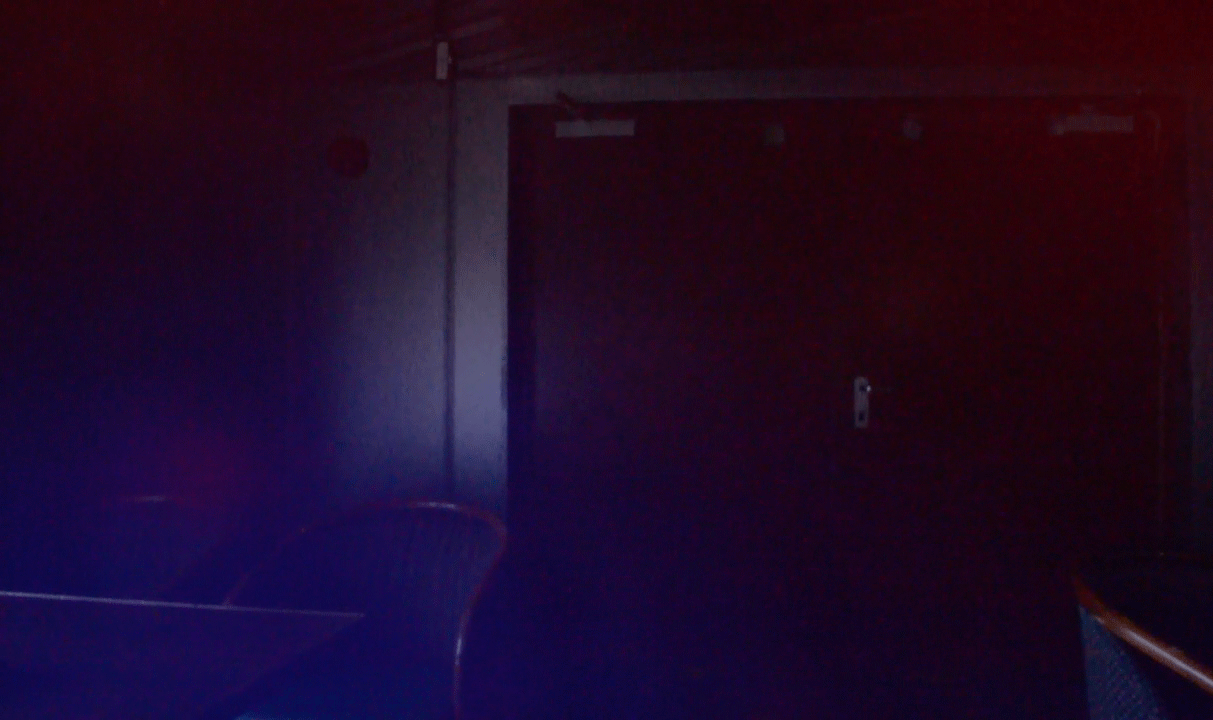


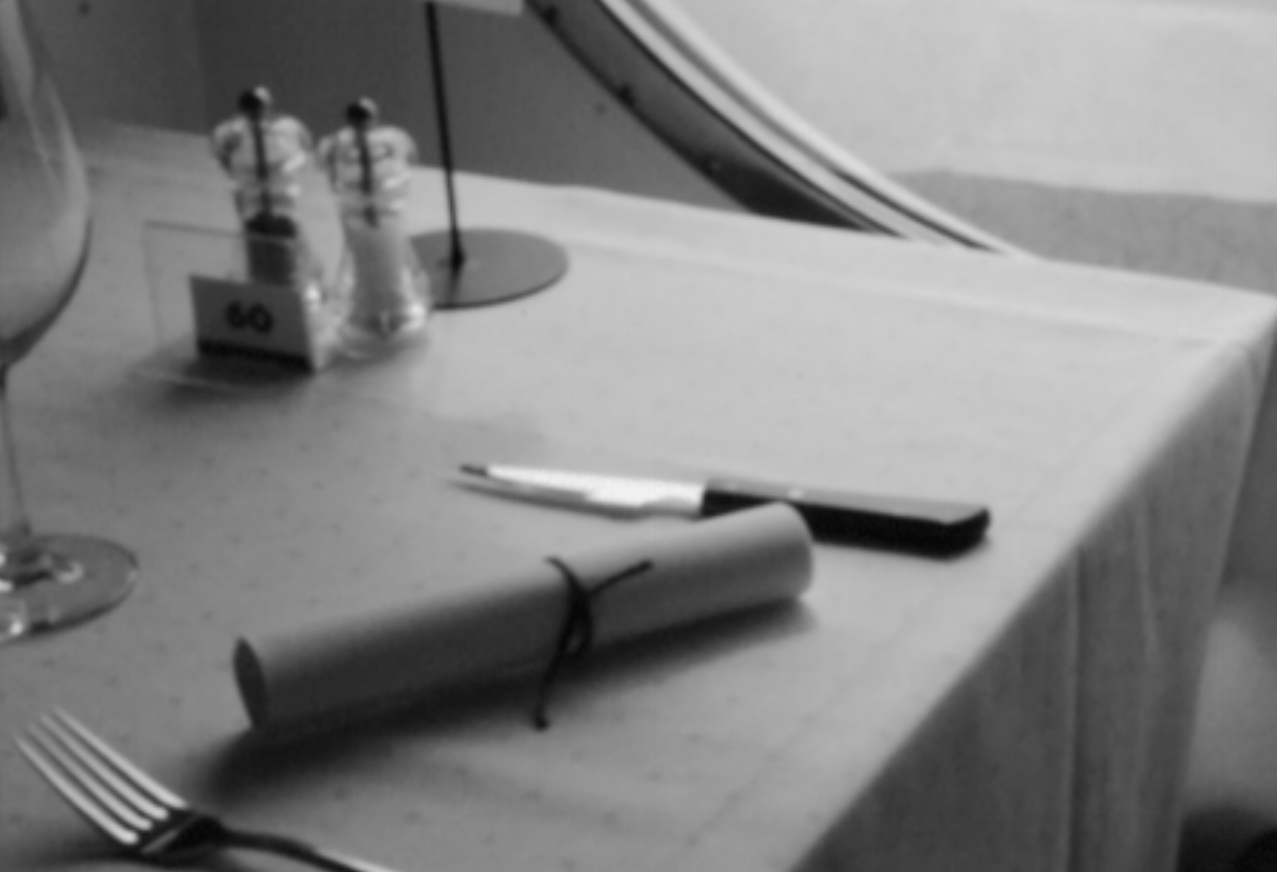
A video and sound installation for a single-viewer aboard VL Rosella that trafficed Kapellskär - Mariehamn. Here we used images and sounds to foil context, time and space. Being out on the ocean can be like entering a kind of vacuum in time and this was something that we experimented with to amplify further via a windowless room (the cabin), to let a sense of dissolution and disorientation get reinforced. In the work empty areas from the ferry, a desert and intimate sonic landscapes got connected.
In collaboration with the musician Jon Lennblad / Credits: VL Rosella
Fönstret åt gården / Rear Window
Installation, 2015








A spatial installation for and about the 100 m2 exhibition art space Kakelhallen (former milk store) in Mariehamn, Åland Islands (FIN) before it got demolished and an exploration about narrating a multifaceted place. The labyrinth worked as a way to arrange several rooms in one space to contrast each other and tell parallel stories with the help of darkness as a portal between what you leave and what you enter.
After passing red velvet drapes and a dark passage you encountered a scene from the building filmed outside with a child dressed in a cape taking her time to mend and spend time with the surroundings. The following space was occupied with several monitors with flashlight films from the building and installation space by night. The path ended with a two-person tent, made by the cape that appears in the film, and the view of the installation space empty and endlessly sliding by at a monitor next to a wall which worked as a writing/message point.
CONCEPT Sofia Romberg / Jon Lennblad PARTICIPANT AND PHOTO John William Häggblom J John William Häggblom
CREDITS Mervi Appel / Svenska Kulturfonden / Kakelhallen / Emmaus / Audiotrade
Holiday
Installation, 2013









